Estimated reading time: 41 minutes.
January/2017 - The EOS 5D family of cameras is one of the most revolutionary on the market. A lineup born to bring top-of-the-line features enthusiast photographers, on a compact body, it conquered a legion of fans that overcome it’s limitations in the name of practicality, ease of use and price that only the 5D line does on the full frame market. The classic 2005 5D was the first to bring a 135 “full frame” sensor on a “compact” body, close to the EOS 30D, bringing together the top 1DS image quality to a portable, APS-C style camera. The 5D Mark II brought together the 1DS Mark III’s high resolution and the 40D’s Live View, launching a new photo-video HDSLR hybrid market, keeping the 40D ancient focusing. The third generation Mark III solved that, borrowing the 1D-X 61-point phase-detection module in a weather sealed body, leaving the high shooting speed and 100K dot metering behind. And the 5D Mark IV repeats the formula, bringing together top-of-the-line features with the APS-C lineup, for yet another revolution on the market: the instantaneous Dual Pixel focusing during Live View from the 70D/80D/7DII; and the smooth, automated focus transitions during a new, high-resolution DCI-4K video recording. It’s the best of both worlds.
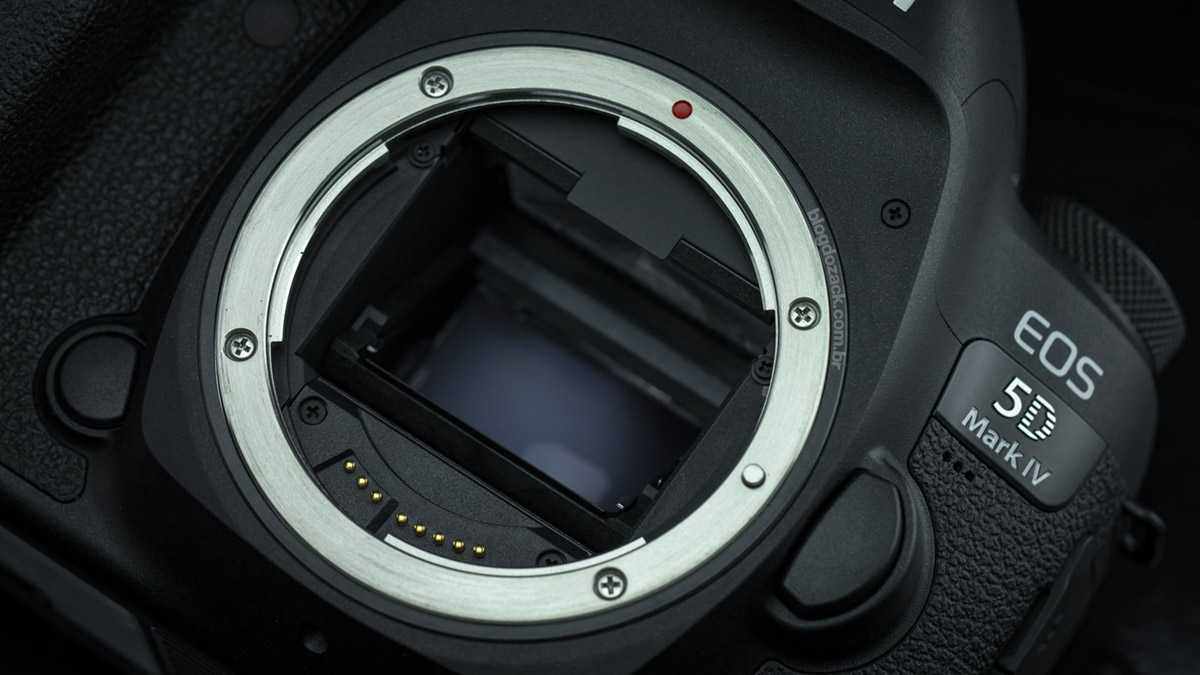
Introduced on the EOS 70D and enhanced on the following 7D Mark II, 80D and M5 APS-Cs, even being employed on the ultra-high-end EOS Cinema lineup, the Dual Pixel is more than just a technology; it’s an unique market positioning rooted on Canon’s auto-focus legacy, that has always been the greatest strength of this brand. Using two photo-cells per pixel (dual pixel), the idea is to transform the camera’s main imager on a distance-sensitive chip, doubling the fast phase-detection focusing module principle, but on a much larger area. Used during Live View, it solves the unreliable, processor-heavy focusing method when the mirror is up; now fail-proof and lightening quick using the image sensor. Although some brands already employed fast Live View focusing using some built-in phase detection pixels, Canon proposes all of the imager pixels sensitive to distance, allowing for greater control, speed or smoothness than any other system on the market.
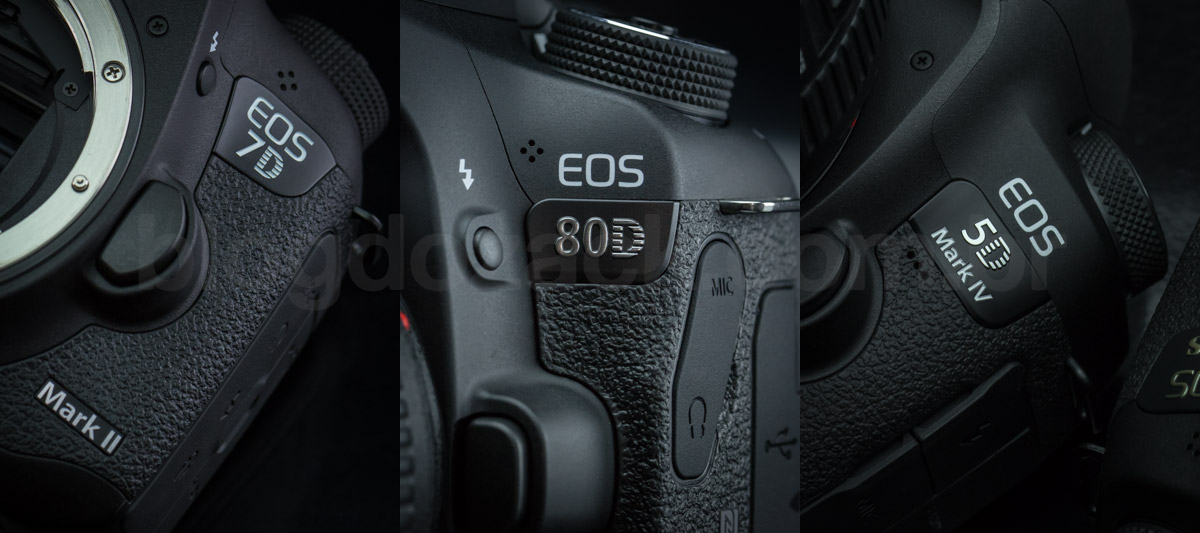
The Mark IV is the first 5D to come with such feature, allowing for new ways of shooting stills and video. Its Live View got completely revamped, faster and offering SERVO AF, together with a touch sensitive interface through the rear LCD panel; totally changing the way we interact with the camera. The DCI-4K internal video recording is made to attend the next generation of video producers, with automated focusing transitions (focus racking) using to the Dual Pixel tech, for never seen before effects, without the need for complicated follow focus gears. For the viewfinder shooting, the Mark IV also brings a new DIGIC6+ processor from the 1D-X Mark II, and the metering + motorized mirrors from the 7D Mark II/5DS, both working together for up to 7 full resolution frames per second. The Mark III 61-point phase detection AF module got upgraded with a new, faster, rear-thumb control. And the also new 30.1MP imager gives extra resolution for photos, without losing the great low light performance we expect from a 5D series, in spite of the Dual Pixel tech. Was it worth it bringing the Dual Pixel to a semi-professional camera? Or Canon should have focused on other areas of improvement? Let’s find out! Nice reading.
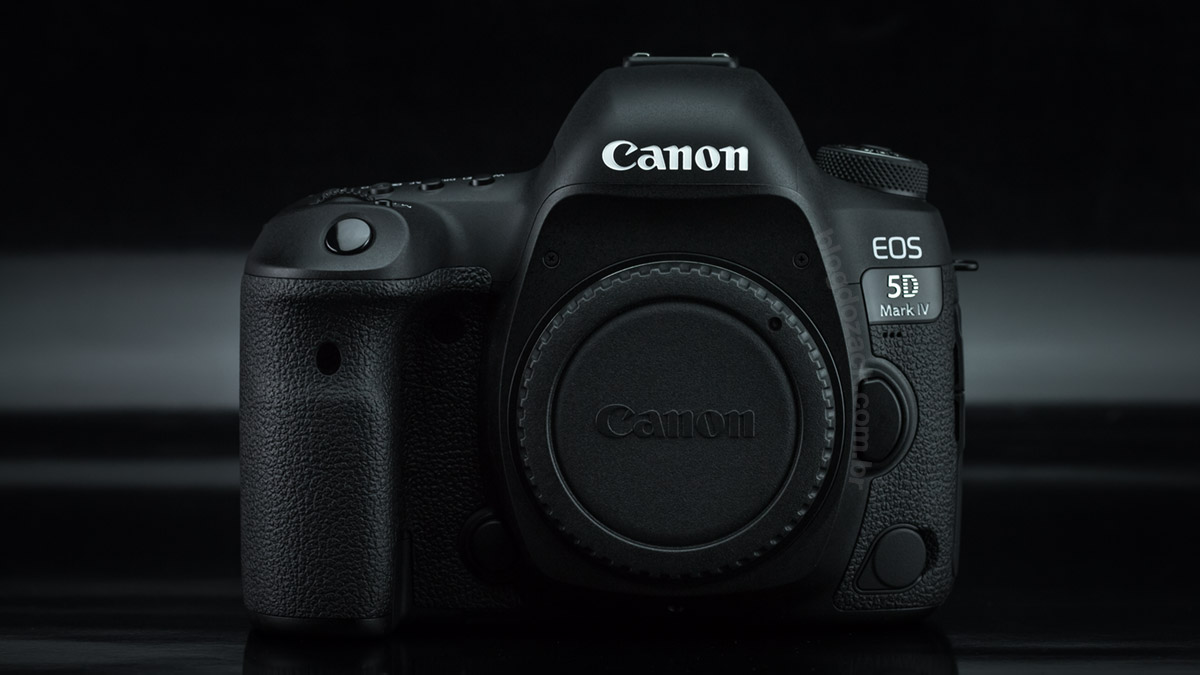
At 15 x 11.6 x 7.5 cm of 800gr, the first thing we notice is the 5D Mark IV size and overall shape, the same as previous models. If in one hand that’s a good thing, as everything is at it’s right place for ease of use, as soon as we get it out of the box, on the other it shows how Canon’s innovation will be incremental from now on, focused the details; just like the EOS 80D that “looked like” (but really wasn’t) a 70D”. The overall build is largely the same, with metal plates at the top, sides, rear and front, with only the new “helmet” cut over the viewfinder, fitting a plastic piece that allows for wireless communications; a 5D first. The solid feel, that doesn’t wobble or cracks even when using the heaviest lenses, is the same, for great handling on heavy-duty works. And around the plastic doors we see the updated weather sealing, featuring proper rubber gaskets in place of the older foam pieces, taller and fatter, for even greater protection. If it all feels the same, what’s changed?
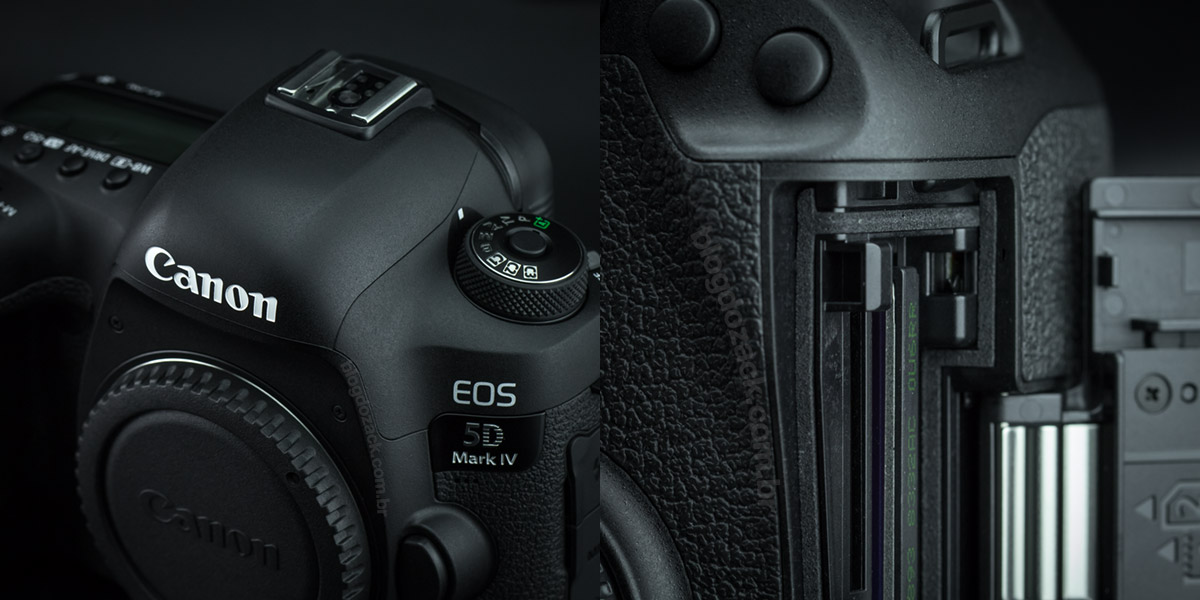
It’s when we get it on our hands on the 5D Mark IV’s, that Canon’s attention to ergonomics becomes indeed very clear. For those with longer fingers, the main design difference is at the right index finger rest area, next to the M-Fn button, that is now curved; way more comfortable than the Mark III sharp edges. It’s such a small detail that impresses how much of a difference it does, especially when carrying the camera around the streets. At the rear, the thumb “valley” is still relatively shallow, not as deep as the new 80D, because the 5D series is taller, heavier, resting on the palm of our hands instead of “pinched” between the index and the thumb. The top LCD also gained a smoother edge, a line repeated on the left side, at the front, smoother, not bothering the photographers hip when he/she carries the camera over the shoulders.
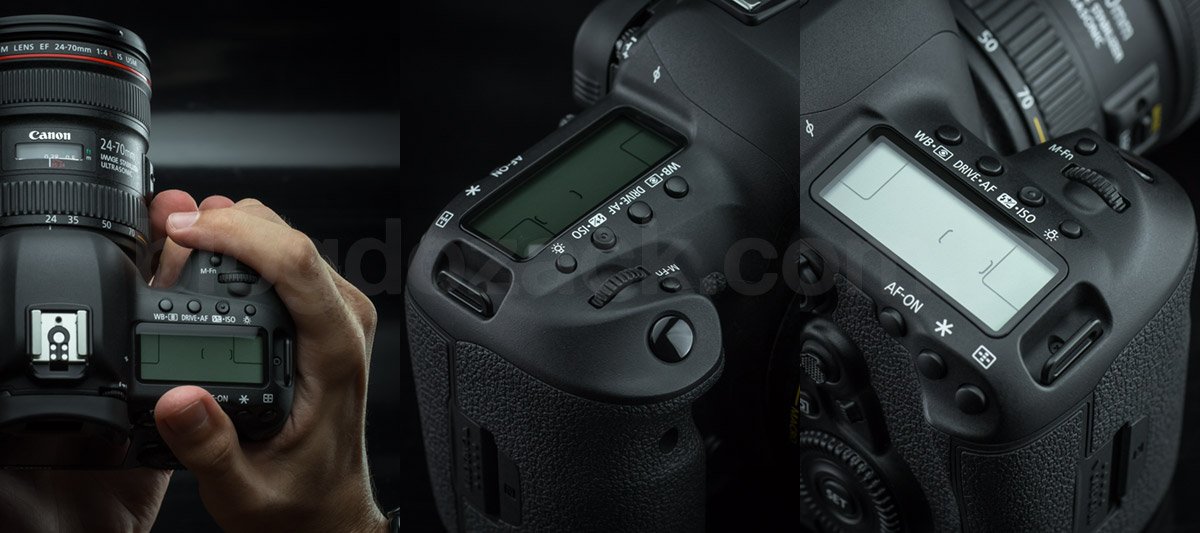
The usability is largely the same as every other EOS camera, with small but significant upgrades. The rear thumb joystick for example, sports a much wider grip area for your finger’s palm to sit; less “spiky” than the older one. It’s much more inviting to “rest” your thumb for longer, together with an all-new AF-point selection mode diagonal button; absent from the 5DS. The Mark IV gained a control similar in function to the 7DII lever, cycling through the AF modes using only your thumb; changing the older “M-Fn” (front) + “+” (shoulder) + “joystick” (rear)” logic, to a simplified “button” (rear) + “joystick” (rear); faster to use, never missing a moment to start proper focus.
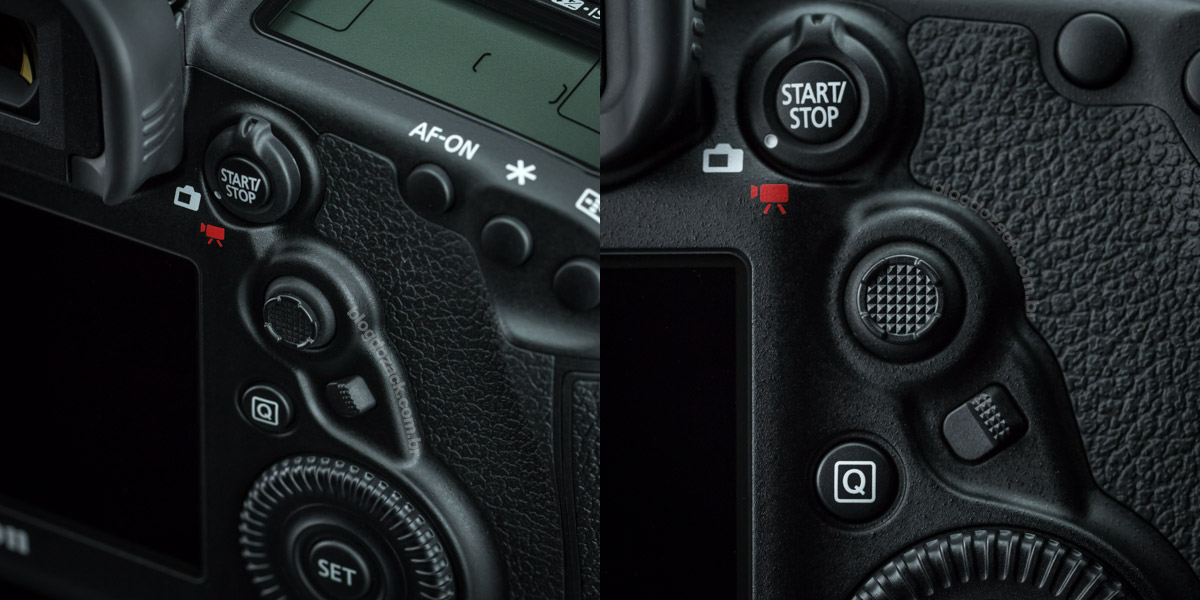
Following the EOS 80D diet, the 5D IV rear panel got new tactile areas surrounding the controls, with higher “steps” around the joystick and the Live View switch, easier to be recognized by touch. The rear thumb dial is much higher to grip your finger from the side, possible to be used even with thick gloves. The Q button starts a dedicated, completely customizable quick menu, and is also higher, better to the touch; probably to follow the new touch-sensitive rear LCD and be used more often. The rest of the WB-Metering, DRIVE-AF, Flash +/- ISO and LCD backlit top buttons are all higher as well, even sporting tiny bumps between the plastic button and the metal plate, for greater tactile precision. It’s Canon’s ergonomics showcase, that can engrave precise cuts on metal plates, never loosing robustness and usability, all made for a lifetime of photos.
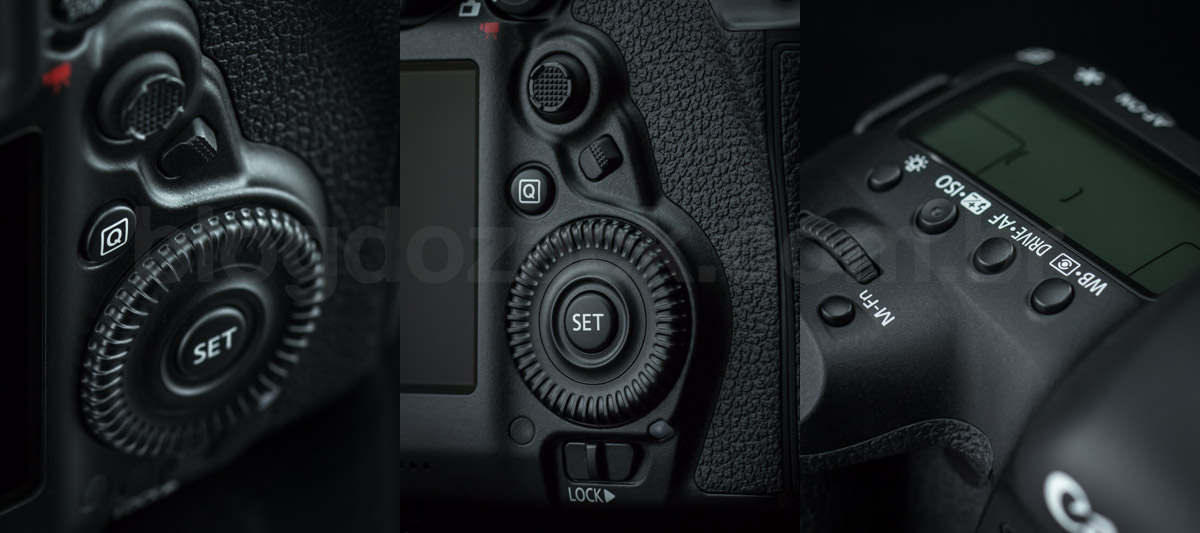
To the side of the big 3.2” LCD screen (we’ll be back for it later), the column of two-hands-operation buttons is largely unchanged from other 5D’s. However, excuse my bitching, but it feels a bit lazy on Canon’s side not enhance this layout. While I do understand the value of an identical button scheme since the Mark II, there’s room for improvement borrowing ideas from different cameras. Take Nikon’s D500 for example, it adds a “+ zoom” playback button together with the “- zoom” (+ and -), much more practical than Canon’s top dial zoom scheme. The D500 also sports a Fn2 button next to the screen, customizable to send photos wirelessly to a smart device (Canon uses the rear SET for that). And I don’t even have to mention Nikon’s backlit wonder: it’s a feature missing from every Canon, and I wouldn’t mind having it copied on the EOS lineup. I know I’m just bitching, but considering the Mark IV added features, it’s time to revamp the 5D button layout.
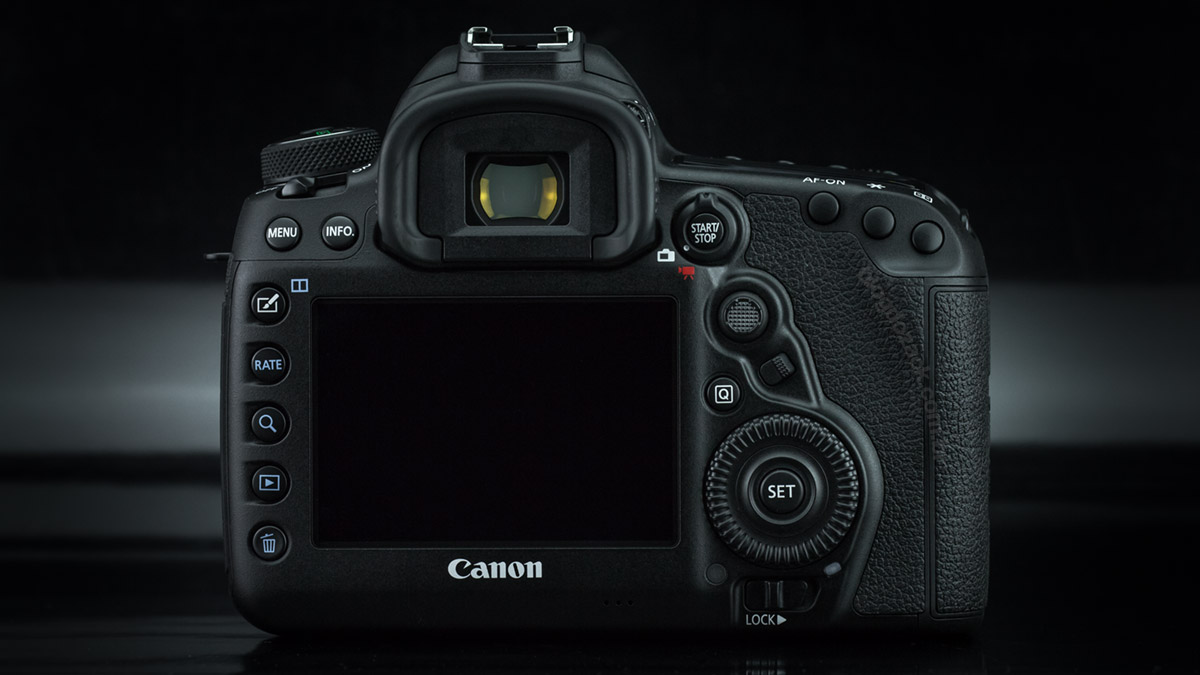
At the top, the painel remains… er… the same? While the main mode dial selection did get updated with a thinner profile, curved from center to edge, and engraved letters (they used to be embossed), and the top LCD buttons are higher… There’s, again, space for improvement, to fit the all-new features. The absence that bothers me the most is the lack of any sort of Wi-Fi indication, present on the Rebel T6i, but not on semi-professional EOSs (the 1D have a LAN LED indicator, pointing the importance of such warning). Mount your Mark IV on a crane to wirelessly shoot a model from the studio’s ceiling, and notice how hard it is to tell if the camera is ON. Also, the top LCD could fit new data about card status, or some video data (time remaining, resolution). If Canon can fit an OLED screen on a US$499 lens, they can surely rethink how we handle a US$3499 DSLR.
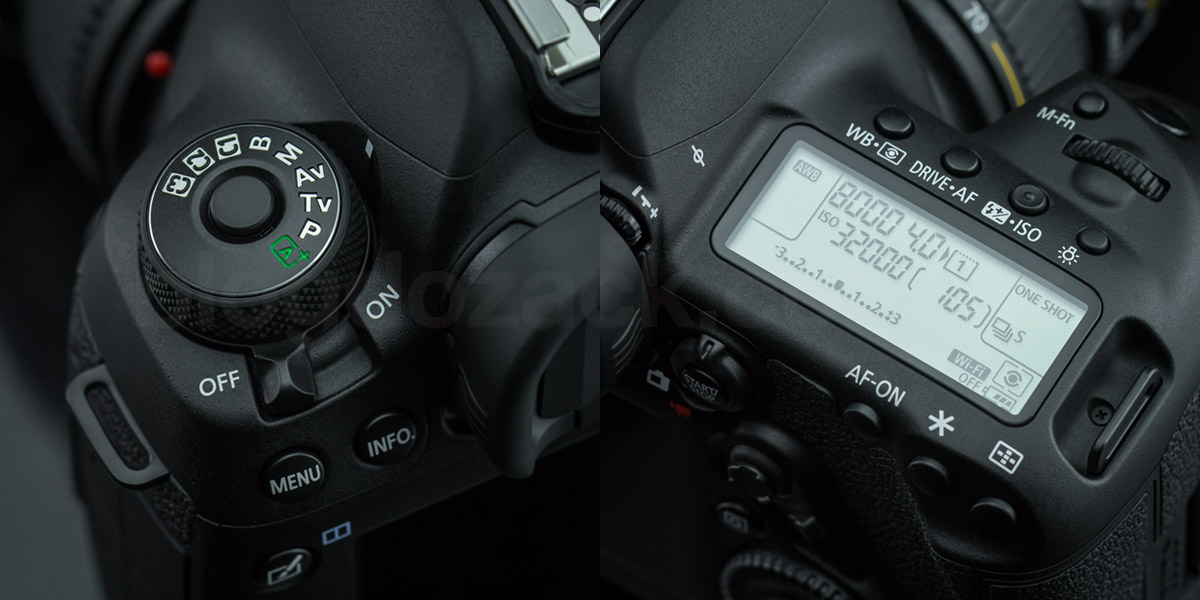
To the left, all camera’s connections were reorganized to better suit each type of work and better weather sealing. The in/out microphone and headphone jacks are on a single rubber piece; that doesn’t open together with the PC sync flash port; now at the top. The USB 3.0 (yay!) and HDMI are together, with a female screw whole to support cable holders, in case you extensively use the camera tethered to a computer or attached to an external video recorder. The remote control plug-in port moved to the front, finally pointing at the right direction: the cable exit to the camera’s left, while on the Mark III/S it inexplicably pointed to the front. On the other side, to the front, the Mark IV keeps Canon’s laziness on the camera’s layout: a single left hand button is programmed to depth-of-field preview, and can be adjusted to various functions; but it sits alone! Practically every “professional” DSLR sports two front buttons, and all Nikon’s, but not the EOS 5D’s.
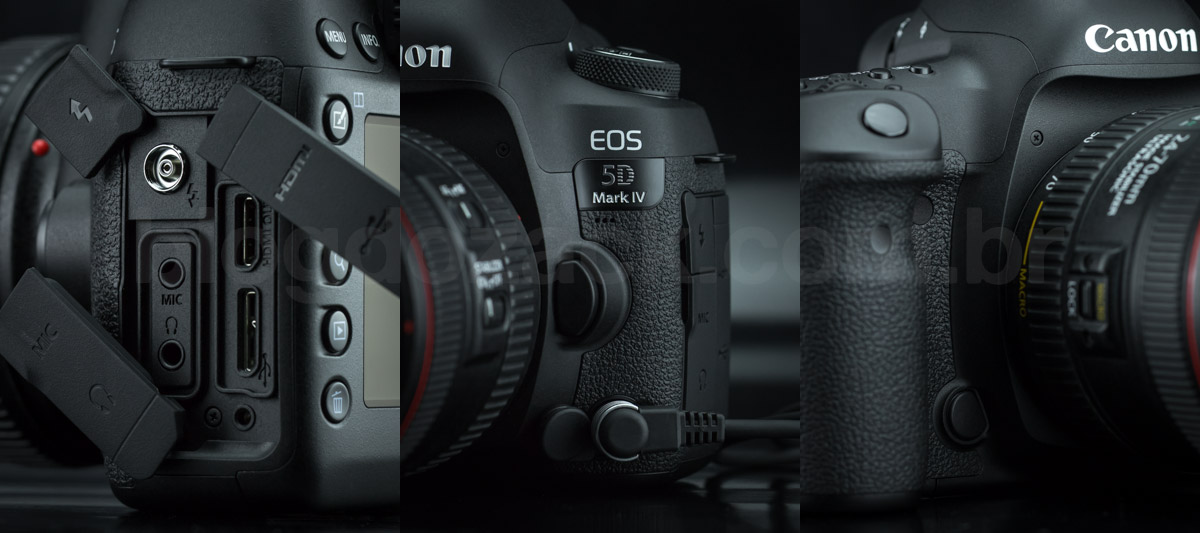
To the right, the memory cards slots are behind Canon’s always sturdy plastic door, but reveal the manufacturer’s last corner-cutting: the BUSes are the same as the 2008 5D Mark II, ignoring any advancement in memory technology from the last… decade! While we can make do with the fastest UDMA 7 Compact Flash cards (167MB/s máx), and even some U3 UHS-I SDs (116MB/s), more than enough for everyday portraits, street photography and some slow-paced events, it can barely handle the 4K MJPEG video capture or the all-new Dual Pixel Raw mode; hard to swallow on a 2016 US$3499 DSLR. Although the memory buffer did double compared to the Mark III, as soon as you fill it up, prepare for long card writing sessions. It’s a strategy to sell EOS’s 1D-X Mark IIs, that accepts newer and faster CFast 2.0 cards, up to 600MB’s; and a shame compared to other brands that already offer faster BUSes (SD UHS-II) on cameras costing half the price of the 5D IV.
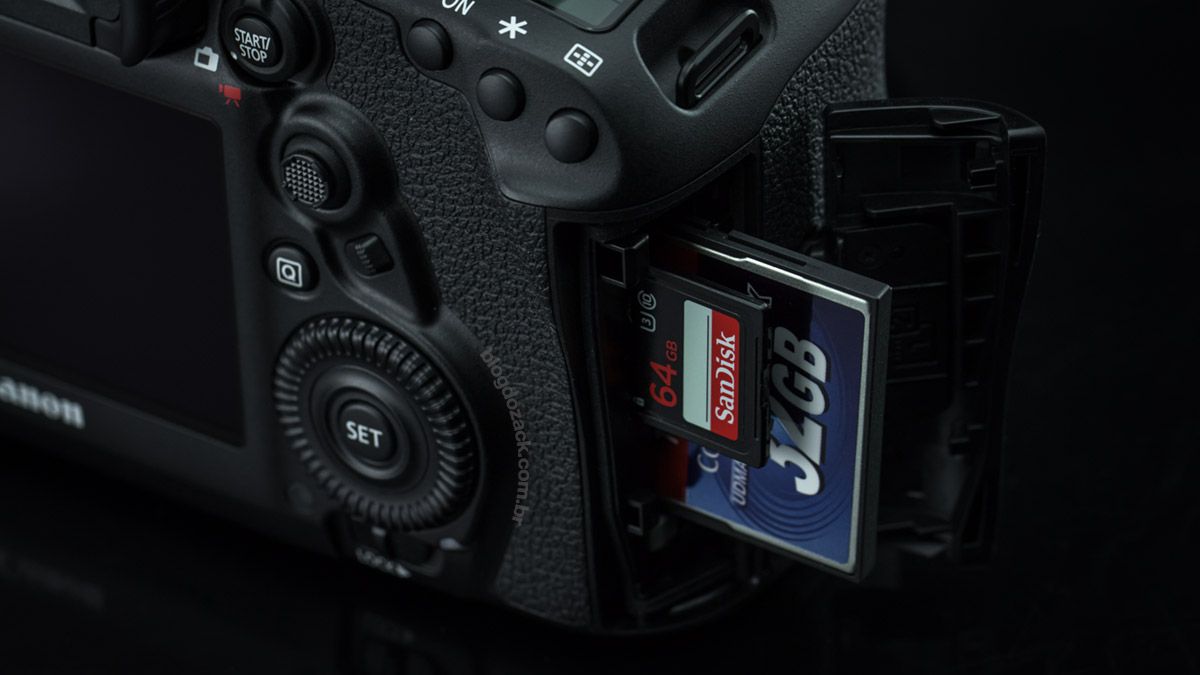
Finally, at the bottom, the LP-E6N batteries are Canon’s greatest legacy since 2008; that don’t need changing (no pun intended). While the Mark IV comes rated at “just” 900 frames using the viewfinder (it was 950 on the Mark III), it’s on Live View mode that things substantially improved: 300 photos or up to 2 hours and 40 minutes of shooting; or 90 minutes of 4K capture; twice of the Mark III’s. It’s a small number compared to the viewfinder shooting, but actually the Mark IV Live View mode is much more efficient than the Mark III 200 photos or 1H30 Full HD capture. So Canon is really taking the rear LCD shooting seriously, and on an everyday basis it’s the same great EOS experience: a single battery can shoot a full portrait session, and you should plan about a pack of battery for each 90 minutes of video shooting. Also the 5D Mark IV accepts the all-new BG-E20 vertical grip (not tested), that accepts two LP-E6N batteries and adds two extra thumb controls.
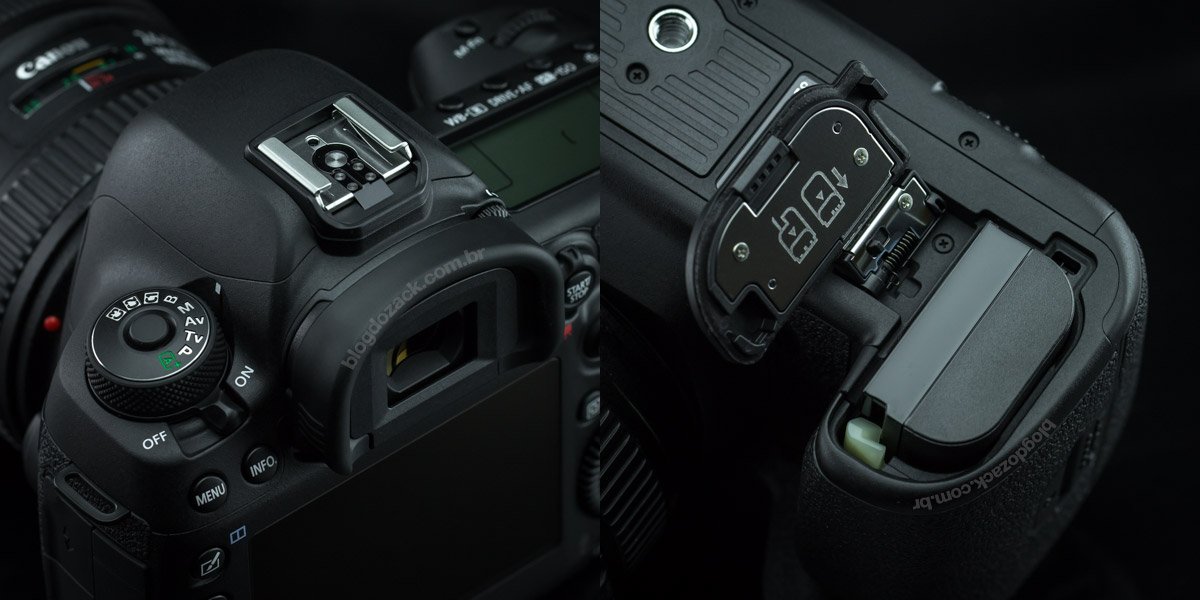
The EOS 5D Mark IV is a natural update for Canon, and a welcome addition to the legion of fans depending on the 5D series. While other brands have a hard time keeping an unified lineup, adding different categories (D800/D750) or launching different cameras (Sony A7II, SII, RII), Canon keeps everything new and everything familiar, at the same time, on a single package. The build quality is great in spite of newer plastic surfaces to allow for wireless communication. Its ergonomics are even better, although it’s hard to notice reading from an internet article. It’s smoother to be carried over the shoulder (rounded edges) or to be in-hands for the whole day; be it with small lenses like EF 40mm f/2.8 STM (the IV is 75gr lighter than the III), or huge lenses like Canon’s extensive 70-200mm lineup (this body just won’t crack under pressure). The controls are even faster for those used to shooting from the viewfinder, finally adding a rear-AF thumb button absent from the 5DS. And the battery duration got greatly improved during Live View, indicating Canon’s intensions to an intense Dual Pixel experience. No matter your style of shooting, the 5D Mark IV is more flexible and robust than ever, filled with features from this generation’s EOS.
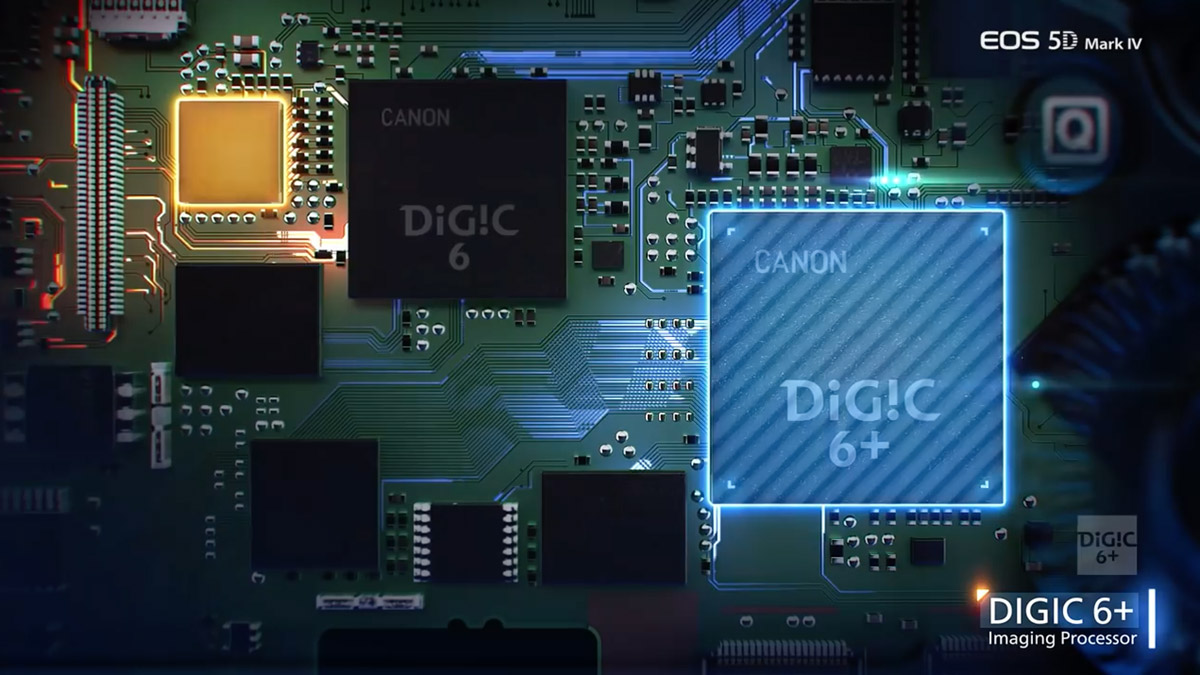
Credits: Canon Inc.
The EOS 5D Mark IV brings the new DIGIC 6+ processor to the 5D lineup, borrowed from the 1D-X Mark II (dual on that camera). While the overall operation speed is largely the same, with a booting time of just 0.05s, responsive menus and continuos full resolution drive for up to 7 frames per second (were 6 on the Mark III), it’s on the image processing pipeline this CPU really shines. Those shooting JPEGs, will see on the Mark IV the same features found on the 1D-X Mark II, thought for those in need of perfect photos straight from the camera. The new Fine Detail Picture Profile, for example, takes advantage of the higher resolution 30.1MP imager, allowing for detailed (pun-unintended) adjustments of fineness, threshold and strength, for rich JPEGs. As seen on the 5DS, 80D and the 1D-X II, it cleverly analises the frame to sharpen only specific areas, much like Adobe’s Smart Sharpen, and avoid that electronic look from overused unsharp mask filters.

An exclusive feature from Canon’s desktop Digital Photo Professional software, is the Digital Lens Optimizer (DLO); for the first time seen in-camera. More advanced than ordinary “lens profile” corrections, the DLO makes a comprehensive optical analysis over the whole light path, considering: 1) lens aberrations (chromatic, geometric, vignetting); 2) Bayer’s low-pass filter, rearranging pixels during data debayer; and 3) diffraction caused by the f/stop used + sensor pixel pitch; all on a single analysis. It’s so clever and precise, that it makes a low-pass filter photo seem from a low-pass-less camera, plus optimizing any selected f/stop to behave like the lens optimized aperture; no matter the diffraction. While it is too heavy on the DIGIC6+, limiting its use to large raw or JPEG only (no S, M or Dual Pixel raws); and bringing the camera to a measly 1-frame-every-3-seconds speed; it’s useful for landscapes and product photography, straight from the camera.

Créditos: Canon Inc.
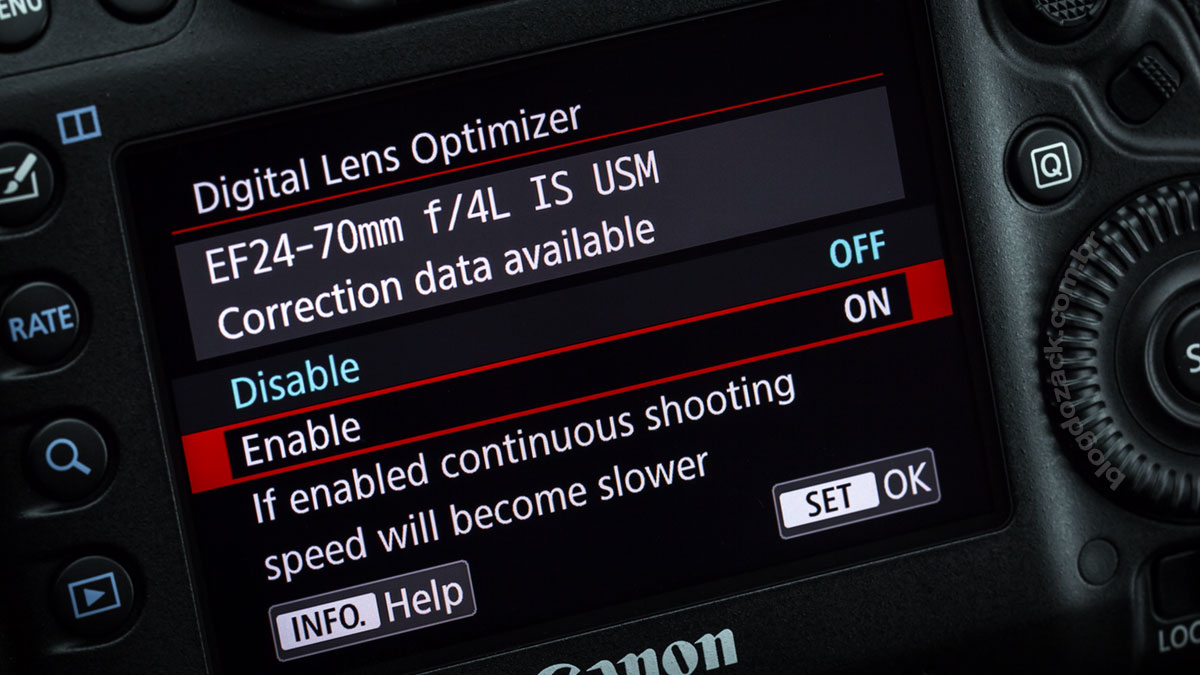
100% crop, in-camera noise reduction (standard) against Adobe’s Camera Raw; they simply won’t compare in texture and details.On the other hand, Canon’s noise reduction algorithm is still a bit weak, giving priority to light differences on each pixel (luma noise), not really fixing their colors (chroma noise). High ISO shots look smudged on colorful shadow areas, once the CPU only merge the pixels next to each other, in order to guess the original light value. Photos gain that watercolor effect on finely detailed zones, as there’s no distinction between contrast areas, fine lines or even the image sensor’s tech (gapless, with or without a low-pass filter); like Sony does on its BIONZ chips (that reduce chroma and luma noise not really loosing sharpness). So for high quality noise reduction, I recommend shooting raw and post-processing files on a computer. Maybe will get a better NR algorithm on the next DIGIC7.
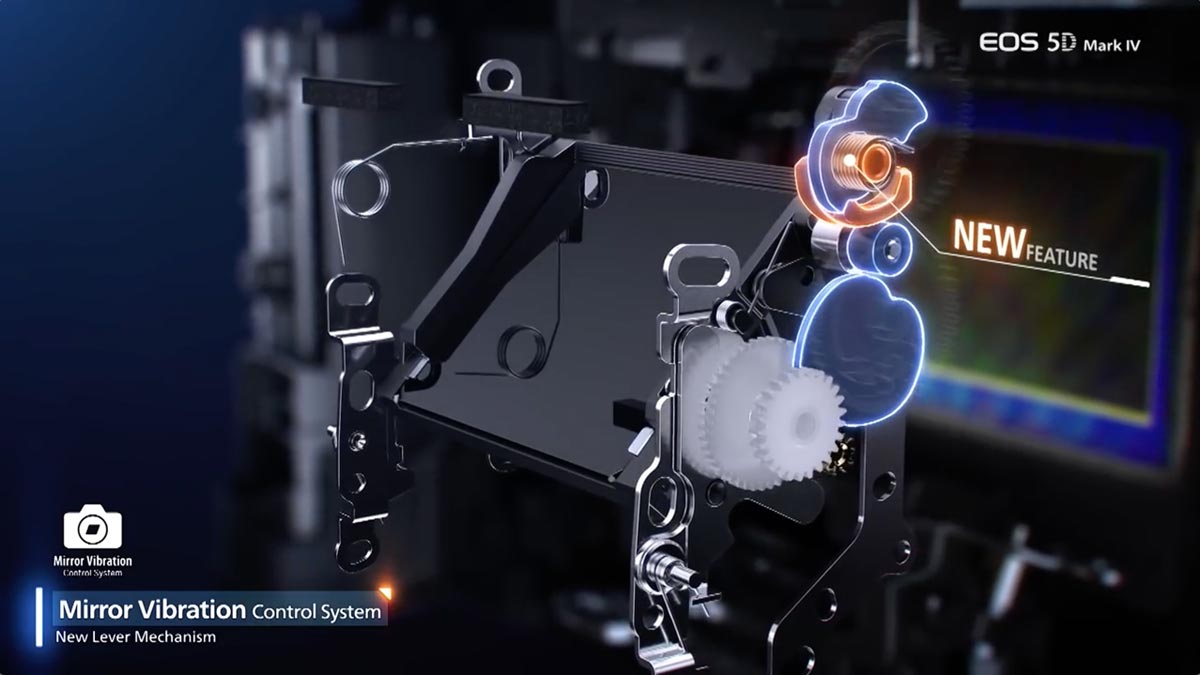
Credits: Canon Inc.
Following every semi-professional (non-Rebel) EOS DSLR from 2016, the 5D Mark IV got the motorized mirror from the 7D Mark II; first seen on the 5D family on the 5DS/5DSR twins. A feature invisibly working inside the camera, the idea is to update the aging spring + counter-weight mechanism of SLRs from the past, substituting it for a motor capable of precisely adjusting the momentum at each mirror-cycle; for smoothness of the moving parts. This smoothness avoids vibrations, guaranteeing sharp captures even on a high resolution sensor. While some advanced mirror functions didn’t made it to the Mark IV, like the instant blackout time from the 1D-X (35ms on that camera, 86mm on the 5DIV, 125ms on the Mark III), nor the delayed mirror lock-up of the 5DS, other functions like a timed-bulb (up to 99 hours) and the built-in interval timer (for time-lapses) are all on the 5DIV; they weren’t on the Mark III. It’s also slightly quieter on Silent mode AND to activate the Live View mode, that will be used often due to the revamped Dual Pixel auto focus. The only EOS cameras still using a spring-based mirror are the T6, T6i, T6s and 6D.

“Oakley” with the EOS 5D Mark IV + EF 70-300mm f/4.5-5.6 DL IS USM at f/6.3 1/1000 ISO200 @ 300mm.
With a motorized mirror and a DIGIC 6+ processor, Canon also improved the Mark IV’s speed. It can reach up to 7 frames per second in full resolution, against the Mark III’s 6 frames; a small step for the 5D lineup, but never seen before on a DSLR at this price point. For instance the Nikon D810, it goes as fast as 5 frames in FX mode; 6 frames in DX mode, and 7 DX’s with the extra battery grip. Sony’s A7 II mirrorless (all) reach only 5 frames as well. During Live View, the 5D IV keeps the 7 frames per second, but only if the SERVO AF is turned off (it drops to 4.3fps with the Dual Pixel ON); more than double the Mark III that didn’t even have a SERVO mode on Live View. While it won’t take the place of the 10-frames-per-second EOS 7D Mark II, nor touches the 1D-X Mark II’s 14fps, the 5D IV might be able to handle fast-paced sports and journalism, as long as you can live with its tight buffer and jurassic memory card BUS, dated from the 2008′s 5D Mark II.
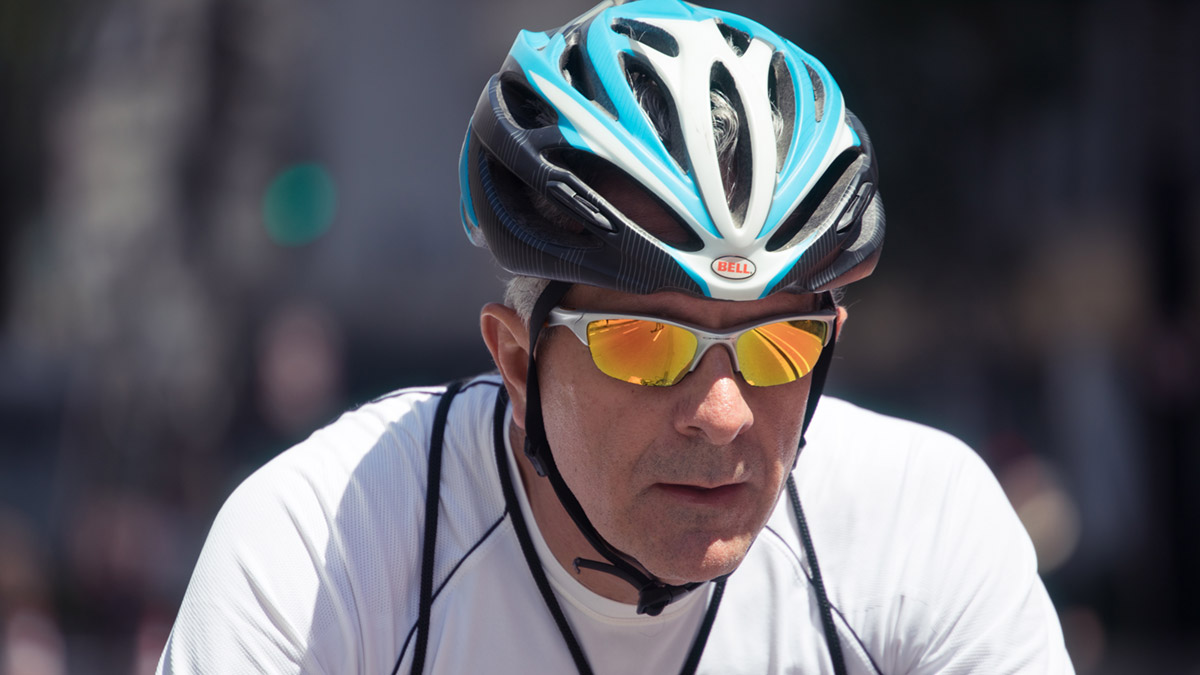
“Oakley” with the EOS 5D Mark IV + EF 70-300mm f/4.5-5.6 DL IS USM at f/6.3 1/1000 ISO200 @ 100% crop, an all-in-focus sequence.
The 5D Mark IV memory buffer doubled compared to the Mark III, for even better performance during continuous shooting. With Compact Flash UDMA 7 cards, the Mark IV can shoot 33 raw files (or 20 raw + JPEG); with SD U3 cards, it goes up to 28 raw (or 18 raw + JPEG); numbers that fall 30% at higher ISOs (each ISO100 raw consumes 30MB, but ISO10.000 uses 40MB), or even half that using the new Dual Pixel Raw mode (60-80MB per file). If in one hand it’s more than enough for most street photographers and usual events, on the other you really don’t want to fill the Mark IV’s buffer. As the memory card BUS didn’t improve, it gets looong writing-to-card sessions, giving a false sense of safety in spite of the larger buffer. With the fastest 95MB’s SD card, the Mark IV takes about 07 seconds to clear the buffer; unacceptable in 2017. So beware not to “rest” your finger on the shutter release, because a full buffer will limit you for a while.
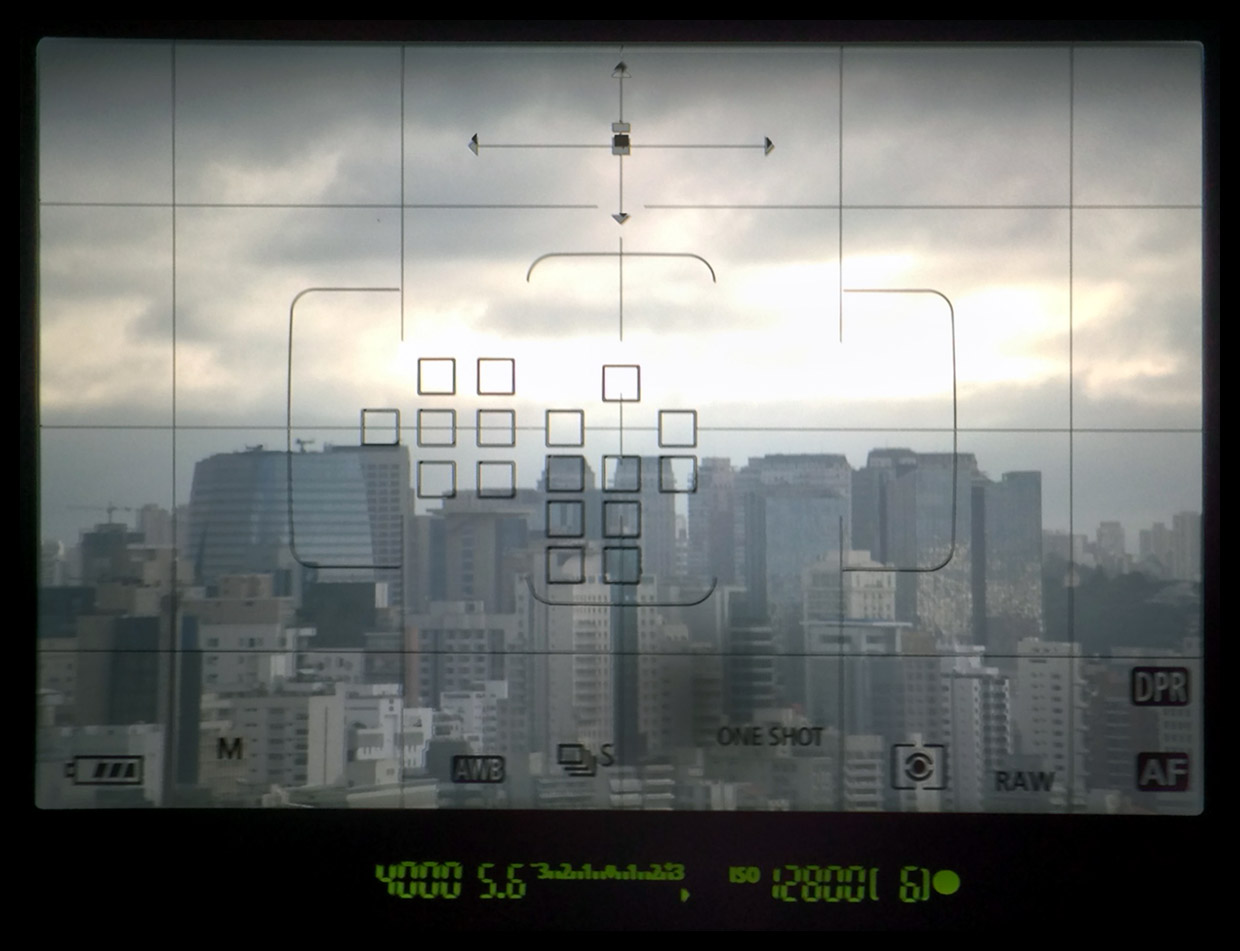
Shooting with the EOS 5D Mark IV can be done in two ways: one through the optical viewfinder, the main idea of owning a DSLR; and another through the rear LCD, like a smartphone. Each have it’s advantages, and the Mark IV revolution stands on the second, that we’ll see later. Starting with the viewfinder, the IV got upgraded to an Intelligent II system (was Intelligent I on the Mark III), with a 100% coverage, 0.71x magnification full frame pentaprism, clear, sharp, free of optical aberrations, for a great viewing experience. The updated Intelligent II uses a built-in black and white LCD to display even more data, like focusing points, a grid overlay – options present of the Mark III – and new battery, exposure mode, white balance, DRIVE, metering mode, image quality, AF, DLO, DPR, flicker and camera level data; all in sight of the photographers view. They’re almost the same as the top LCD, but rendered in the optical viewfinder at all times. It all can be illuminated in the dark, including the focusing points, usable under any circumstances.
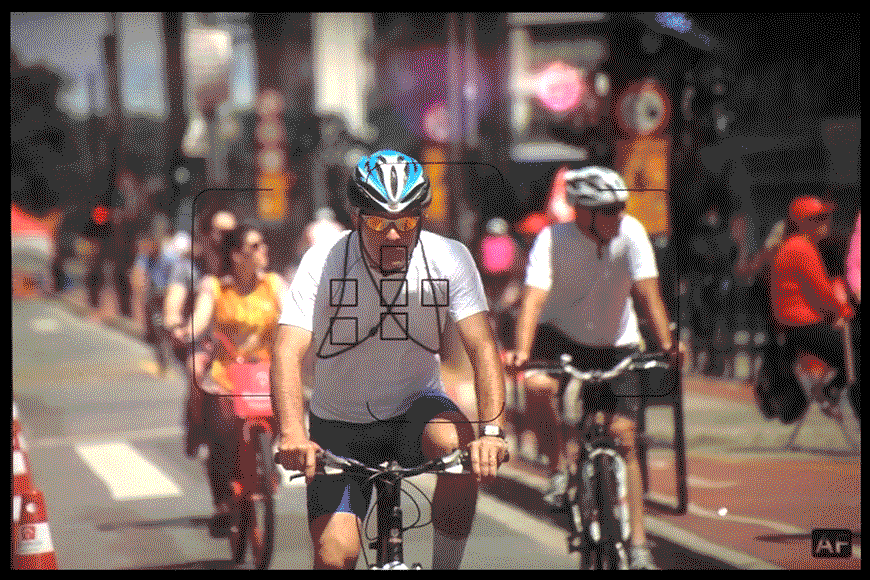
The Mark III versus Mark IV AF points spacing.To follow the viewfinder + mirror shooting, Canon updated the revolutionary (between Mark II and Mark III) 61-point phase detection AF module, now much more sensitive to light and covering a slightly larger area. The vertical spacing increased by 23%, for more interesting compositions with your subject not at the center-frame. Of the 61 accessible focusing points, 41 are cross-type sensitive to vertical and horizontal contrast; the center 5 are dual cross-type, vertical, horizontal and diagonal, all high precision for f/2.8 or larger lenses; and the center point focuses with half the light up to -3EV (it was -2EV on the Mark III). The biggest headline, however, is all these points are f/8 sensitive (most were f/5.6 on the III), greatly expanding the AF compatibility with longer telephoto lenses + extenders. For example on the Sigma 150-600mm f/5-6.3 DG OS HSM review, tested on the 5DS (based on the Mark III AF), that camera allowed for only a few AF points; that doesn’t happen on the Mark IV, that use every AF point to track subjects in every direction.
The AF SERVO III menu system remains largely the same, with detailed adjustments to Canon’s predictive focusing algorithm. Six pre-adjusted cases focuses (no pun intended) in sports and action, varying in sensibility, speed and acceleration; much more sophisticated than any other brand. Nikon tried something similar on their recent D5 and D500, but the interface is poor and limited. Fujifilm experimented on the X-T2, copying the pre-adjusted cases, but its focusing area is ridiculously small at 50%. Sony, on the other hand, offers nothing similar on its 4D Focus. On the Canon EOS 5D Mark IV, there’s also seven AF point selection modes, all instantly selectable through the rear button + joystick: Spot AF (precise to shoot through fences); one point (a single person on a group); Expand AF area (one point + four assistive points, great for tracking a single subject); area:Surround (nine points), zone and large zone (the whole module divided by three); and Auto Selection, the last one assisted by a huge update on the 5D Mark VI: the new 150K RGB+IF points metering from the 7D Mark II and the 5DS, with a high-tech twist.
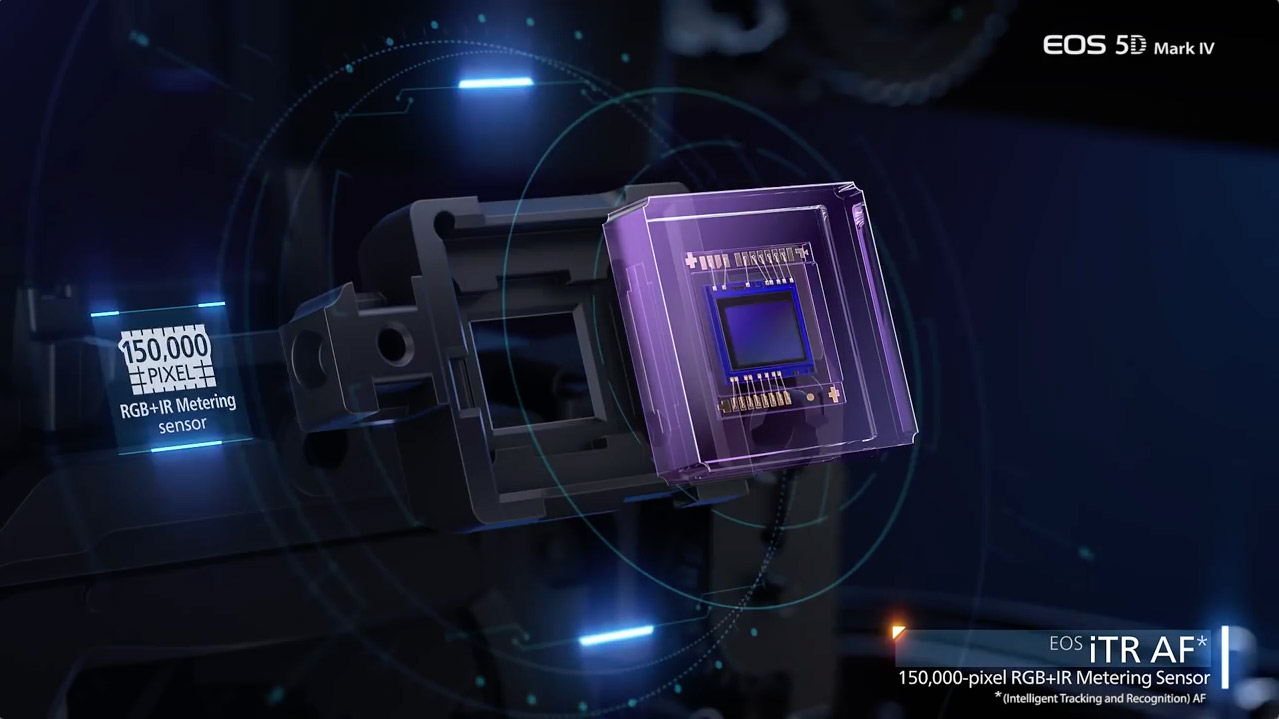
Leaving the Mark III measly 63 zones iFCL metering behind, the 5D Mark IV got the “new” iSA iTR 150.000 RGB+IF points metering seen on the 7D Mark II and 5DS. But Canon pushed it a step further on the 5D Mark IV: it has a dedicated DIGIC6 (not “+” plus) CPU just for the metering, the same as the 1D-X series featuring a dedicated metering processor. While both the 7DII and 5DS are near flawless in spotting and tracking humane subjects, given their infra-red shadows detected by the camera’s metering, it’s not impossible for it to follow hands, arms, shoulders and necks; focusing on the face by luck. The 5D Mark IV solves that with a much more detailed analysis over the 150K metering, thanks to the extra DIGIC6, deliberately focusing the iTR on the subject’s face.

On the other hand, some phase-module limits are still lagging behind the market. For example, it can’t do that awesome eye-tracking – not just face tracking – seen on this generation’s mirrorless (Sony A6300, Fuji X-Pro 2, X-T2 and X-A2). Canon’s focusing system also can’t match Nikon’s 3D Tracking, made to substitute the “focus and recompose” technique. Nikon’s D cameras use advanced meters (91K points on the D800/D750, 180K (!) points on the D500) to isolate a tiny frame area and track it, no matter it’s color, shape and depth; prioritizing the X and Y axis. That’s very useful to point the camera to a single point (like the eye) and let it select the other points; something Canon has nothing similar on it’s viewfinder shooting. Canon always prioritize the phase-module depth Z axis over the metering X and Y, and can’t match the 3D-tracking.
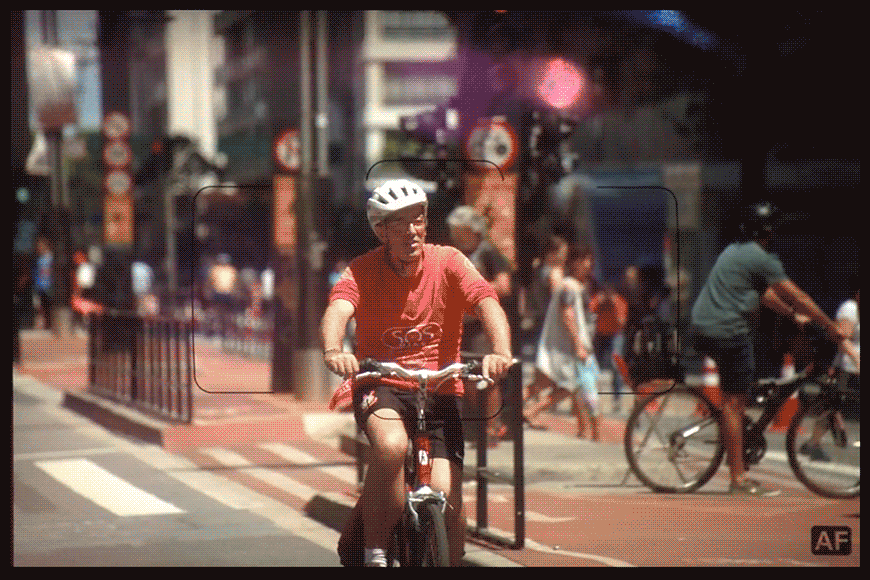
Also, the 150K metering features the iSA, intelligent scene analysis, to analise the scene in front of the camera, through the viewfinder; and optimize white balance and exposure, besides calculating the light flicker. Used mostly with the evaluative metering mode (dot between brackets), the iSA gets adequate exposures of backlit subjects, landscapes at dusk or product photography; all practically without any compensation from the photographer. The Auto ISO also allows for compensations based on the lens focal length; one thing we used to make manually, but now programmed on the camera’s metering calculations. For example during manual exposure mode (aperture and shutter speed), we can let the camera decide the lowest ISO possible, in order to avoid excessive noise, and still take advantage of stabilized (IS) lenses. Finally this metering is capable of measuring the light flicker frequency, in order to synchronize the camera shutter when the light covers the whole frame; specially useful inside closed venues. There’s nothing similar from mirrorless cameras, and the metering module is the DSLRs most advanced features nowadays.

Besides the new features when shooting through the viewfinder, Canon focused (again, no pun-intended) on the 5D Dual Pixel full frame; solving practically all previous generation’s issues during Live View. At the rear, the Mark IV LCD screen looks identical to the Mark III, at 3.2” at 3:2 ratio (the same as the image sensor), with a fixed (non-swivel) structure and a Clear-View II panel; the TFT screen sits closer to the outer plastic, to reduce reflections and improve contrast. On the Mark IV, Canon enhanced the pixel count to 1.6M, 50% more than the Mark III/S, almost “retina” to smartphone’s standards. Also the Mark IV is the first EOS to allow for selectable color profiles on the rear LCD, with options for colder or warmer tones; to match your studio’s screen. But non of that rivals the 5D Mark IV main new feature: it’s touch sensitive to finger inputs, giving a new dimension to the Dual Pixel usability during still photography or video capture, instantly selecting the subject to focus. It’s something no other full frame offers right now, from any brand.
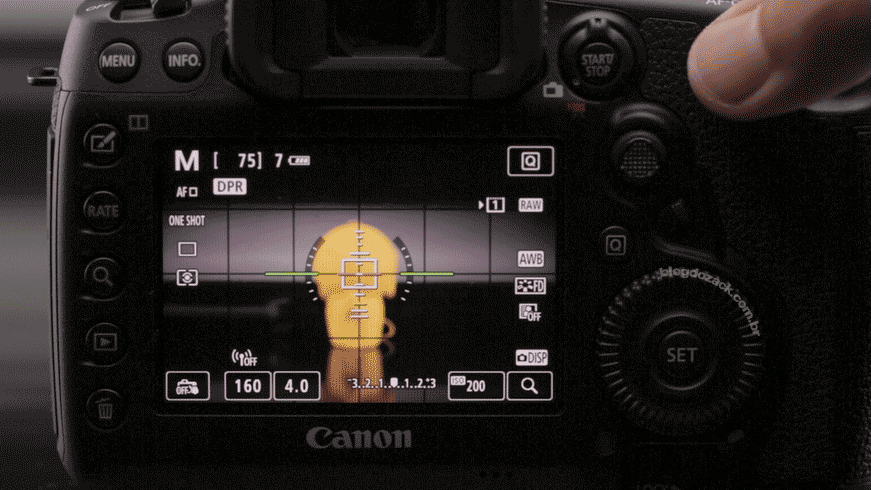
“Dark Room” with the EOS 5D Mark IV + EF 24-105mm f/4 L IS II USM at f/4 1/30 ISO640 @ 24mm.Canon’s biggest bet on the 5D Mark IV is the implementation of the Dual Pixel tech, now on a full frame camera. With two photo cells per pixel (dual pixel), the camera’s main sensor doubles as a phase module, with millions (30M) dots of distance data; perfect to speed up focusing or tracking subject, when the SLR mirror is raised. The AF coverage is at 80% of the frame, area needed to “see” to opposite sides of the same spot (the phase principle); higher than any mirrorless. Not happy with its speed, Canon enhanced the Dual Pixel sensitivity, from the 7D Mark II’s 0EV to a whopping -4EV on the 5D IV’s; half the light needed by the phase module center point (-3EV), but here in 80% of the frame! It’s so impressive I guarantee you: if you’re having issues focusing with the viewfinder, specially in the dark, give the Live View a chance to focus even at the hardest situations. It’s Canon’s biggest bet on the Mark IV, a new paradigm for the 5D lineup.
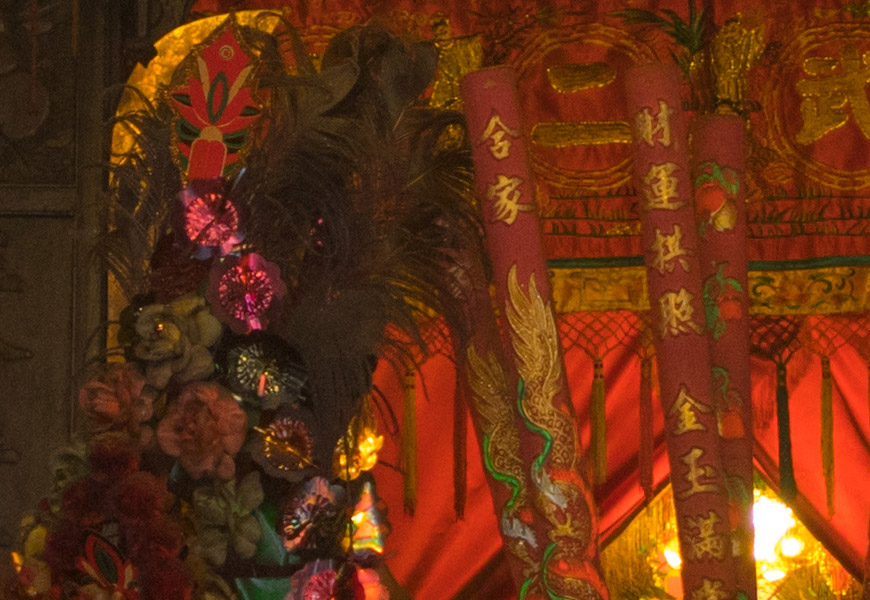
100% crop, instantaneous and precise focusing in the dark, thanks to the Dual Pixel Live View.
“Barrel” with the EOS 5D Mark IV + EF 24-105mm f/4 L IS II USM at f/4 1/30 ISO640 @ 24mm.With all these qualities, guess what: I used the Mark IV’s Live View for most of the pictures shown on this review. As the AF is instantaneous, there’s no fear in “missing the moment” due to the LCD lag; as long as the Live View is activated, and now with twice the battery duration, it’s immediate to achieve focus. As the AF area selection is actually faster, just by touching the subject on the screen (not selecting the point with a tiny joystick), it’s near impossible to miss shot. As it is sensitive up to -4EV, it makes more sense around the streets, or inside closed venues. And most importantly, as it happens on a dense, 30MP area filled with distance information, there’s never a chance for imprecisions, like we’re subject to using the older phase module. The Dual Pixel AF essentially retires the “AF MicroAdjustments”, for sharp photos every time, no matter the lens calibration.
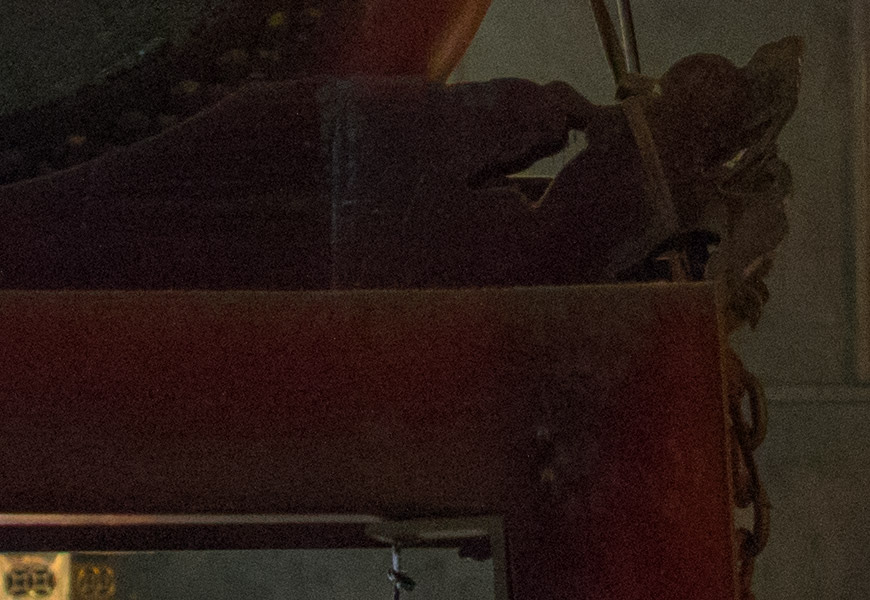
100% crop, to use the Dual Pixel Live View makes more sense inside dark temples, as the -4EV sensitivity guarantee sharp focus every time.
If shooting static subjects was easy for the first generation Dual Pixel (70D, 7D Mark II), on its second generation (EOS 80D, M5, 1D-X Mark II, 5D Mark IV) Canon is adding it’s most famous AF mode: the continuous, predictive SERVO AF, now during Live View. Just as shooting though the viewfinder, the Dual Pixel Live View allows for moving subjects tracking, from shot to shot, calculating its vectorial movement in order to prepare the lens focus for the next shot. A blue box indicates the SERVO mode during Live View, that “sticks” to a subject and adapts for its focus, never missing the right position. The subject can be selected both ways, manually by touching the screen or automatically with face detection, that’s as precise as 90º; your subject can be positioned sideways that the camera will find it. It’s so precise and reliable, I recommend using it at all times.

“Ironman” with the EOS 5D Mark IV + EF 70-300mm f/4.5-5.6 DL IS USM at f/5.6 1/1000 ISO200 @ 300mm.
On the other hand, the continuous drive during SERVO AF on Dual Pixel’s Live View still can’t compare to the mirror + phase module shooting on the 5D IV. As the shutter opens and closes in front of the image sensor, covering it’s sight, the Mark IV is limited to just 4.3 frames per second auto focusing in Live View. So I can’t recommend it for fast action like most sports. But remember: 4.3fps the Mark II did using its mirror, and the Mark IV does it during Live View; a big advancement over the years. Also, it’s not rare for the tracking box to loose the subject, especially if other stuff gets in front of it; no matter how you set the camera to ignore them (Locked-on tracking). But to shoot portraits and some calm events, given the super Dual Pixel precision, the Live View shooting is worth giving a chance on the Canon 5D Mark IV; it’s new selling point.
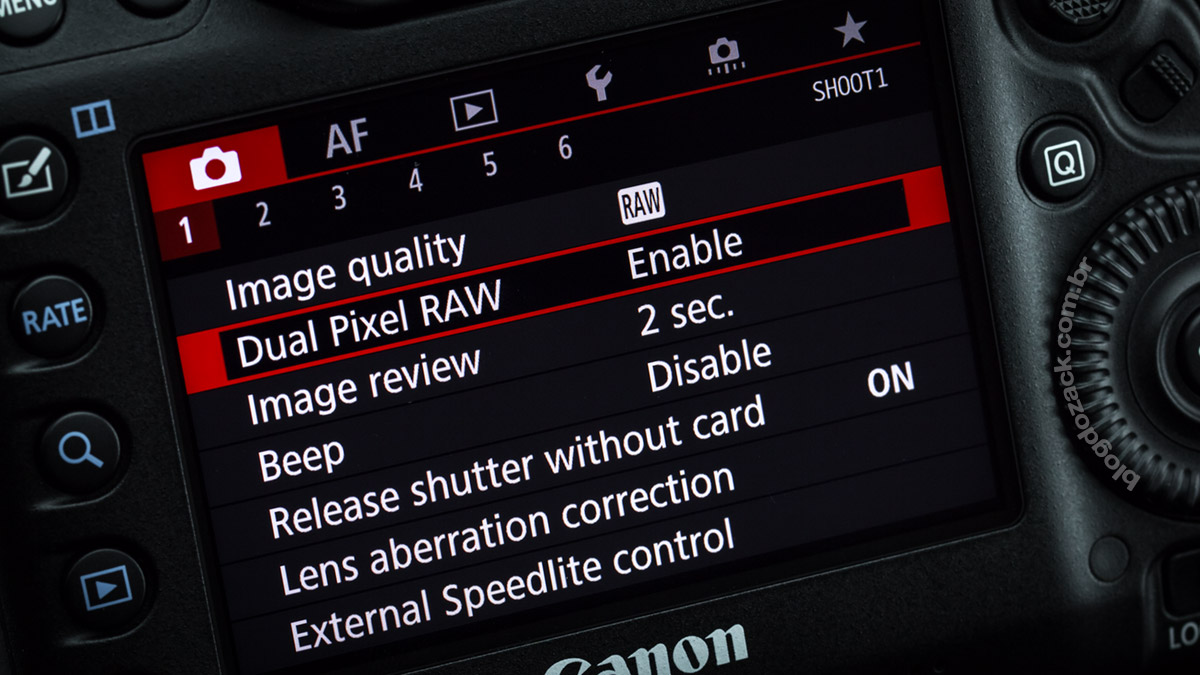
If calculating the focusing distance wasn’t enough, on the 5D Mark IV Canon began experimenting with sophisticated image processing using the Dual Pixel data; using each pixel parallax. Limited to Canon’s Digital Photo Professional for now (no Adobe compatible plug-in), the new Dual Pixel Raw camera mode record both pixels readouts on a single file, doubling its size (about 70MB at ISO100) to allow the computer software to adjust: micro focus after the click (yes, you read that right: focusing adjustments after the click); change the background perspective (that Canon’s calling “bokeh shift”); or even reducing lens ghosting. It’s something never seen before on the full frame photography market, and showcases Canon’s future plan for the Dual Pixel tech.

The “Image MicroAdjustment” setting is potentially the most bizarre I’ve ever seen on an image processor. With two sliders arranged on a T, one vertical for depth adjustments (front and back), and another horizontal for strength, it attempts to digitally refocus the image back and forth from the captured focusing point. It’s exactly how you read it: to refocus the shot on the computer screen, using sliders on the editing software. And the worst part: it works. And it works well! Although the refocusing capability is extremely limited, at about less than 1 single millimeter including front and back, it’s more than enough to completely change the appearance of animal hair or product textures, giving new life to files that otherwise would be deleted. No, the Image MicroAdjustment” won’t completely refocus any disasters, like changing the focused person on a group shot, or between an eye and the nose on a close-up portrait. But for what it does, even as limited as it is, it’s already bizarre and we can only applaud Canon for trying something so unique on such a popular DSLR. Bravo!

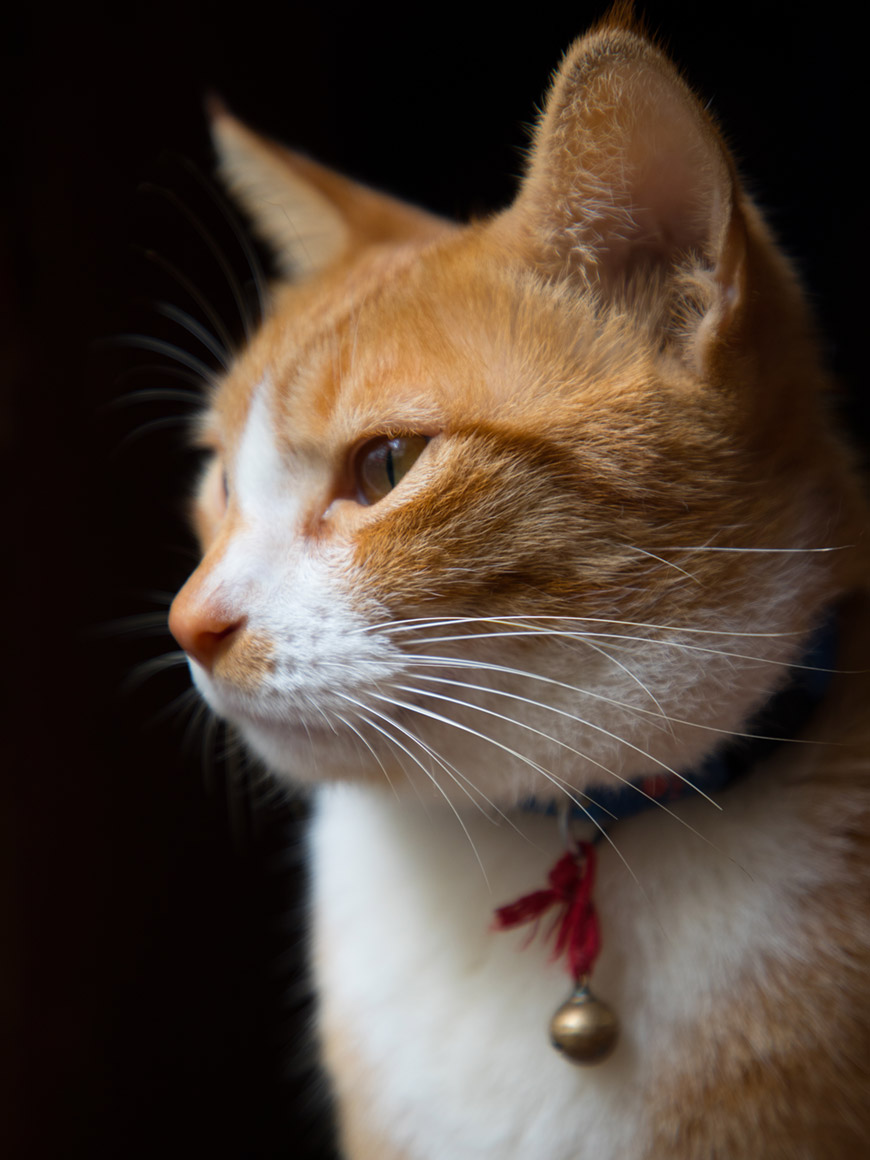
“Cat” with the EOS 5D Mark IV + EF 24-105mm f/4 L IS II USM at f/4 1/100 ISO500 @ 105mm.
The Bokeh Shift on the other hand… Honestly? It’s even more bizarre! :-D Taking into consideration the tridimensional depth data (two X and Y, thus an estimated Z) in each pixel, and adding it to the sensor’s debayer (that interpolates data to deduce the image’s color), the idea it to change the perspective based on the background position, compared to the in focus plane; for slight aesthetic changes between front and backgrounds. Did you get it? Nope? I’ll explain it again! As the image sensor “sees” two opposite sides of each image, it’s possible to recreate two different perspectives for one click, changing the final image angle. Have you ever shot a short depth of field image with a background that didn’t really looked good, maybe creating horns with fuzzy background lines, Mickey mouse ears with giant highlight spots; or wished to hide some background distraction? The Bokeh Shift sliders allow that, and the results are even more apparent than the micro adjustment.

“Flowers” with the EOS 5D Mark IV + EF 24-105mm f/4 L IS II USM at f/4 1/320 ISO100 @ 105mm.; left and right bokeh shift.It’s that simple: a +5 right | left 5+ slider and an area selector. If the whole picture is selected, the whole perspective changes. If you want to compensate for a small area (like behind the model’s head), you can do just that. Noticeable mostly on shallow depth of field photos (you can’t change any photo perspective), the Digital Photo Professional recalculates the background date without changing the in-focus plane. It’s possible to completely change your picture with brighter highlights, whole bokeh balls may come and go, fine fence lines disappear, you can hide people… And as the data is optical, registered by the image sensor, not interpolated via software, the results are flawless, smooth and colorful. Again, we must applaud Canon, always bad talked for its lack of innovation, but there with an useful idea, that we can’t even imagine from other brands.
Last but not least, the “Ghosting Reduction” is note as impressive for now, but also the least necessary. “Ghosting” happens when untreated glasses inside the lens reflects the image among other surfaces, generating flaring and various color aberrations when we point the camera at bright light sources. Sometimes used for special effects, sometimes an undesirable consequence of certain perspectives, flaring rarely happens on modern lenses, as most manufacturers invest heavily in all types of treatments. As the Dual Pixel sensor “sees” two different perspectives, guess what? It can change the angle of the light reaching the sensor, thus reducing flaring and ghosting. The results are usually very light, reducing the reflection exposure, besides the software algorithm doing impressive calculations to handle it (try using it with any picture, to see what happens). So it demonstrate Canon’s intentions in using the Dual Pixel tech to compensate for optical flaws, as well as other clever adjustments that only the 5D Mark IV is capable for now. Awesome!


“Ching Chung Koon II” with the EOS 5D Mark IV + EF 24-105mm f/4 L IS II USM at f/8 1/30 ISO2500 @ 24mm.
Another major update on the 5D Mark IV is the DCI-4K EOS Movie; by far the biggest wish from videographers based on the 5D lineup, but implemented in Canon’s EOS signature style: with bizarre limitations in functionality, not to cannibalize sales from higher-end cameras. It’s main headline is the DCI-4K (Digital Cinema Initiative) resolution at 4096×2160 up to 30 frames per second, recorded in Motion JPEG at 500Mbps (!) with Linear PCM audio; wrapped in a .MOV file. The FullHD 1920×1080 resolution now reaches 60fps, with a HD 1280×720 High Frame Rate at 120fps – both twice the Mark III -, recorded with ALL-I or IPB H.264 or MPEG-4 codecs; and optional AAC audio. Files are saved internally to any of the memory slots and a 1080P60 feed can be sent uncompressed through the HDMI port (no 4K). All exposures modes are available (P, Av, Tv, M) and the video native ISO range is 100-25.600 (12.800 in DCI-4K). The 5D IV is the most feature-full EOS HDSLR besides the 1D-X II, and a fraction of the cost of the EOS Cinema cams.
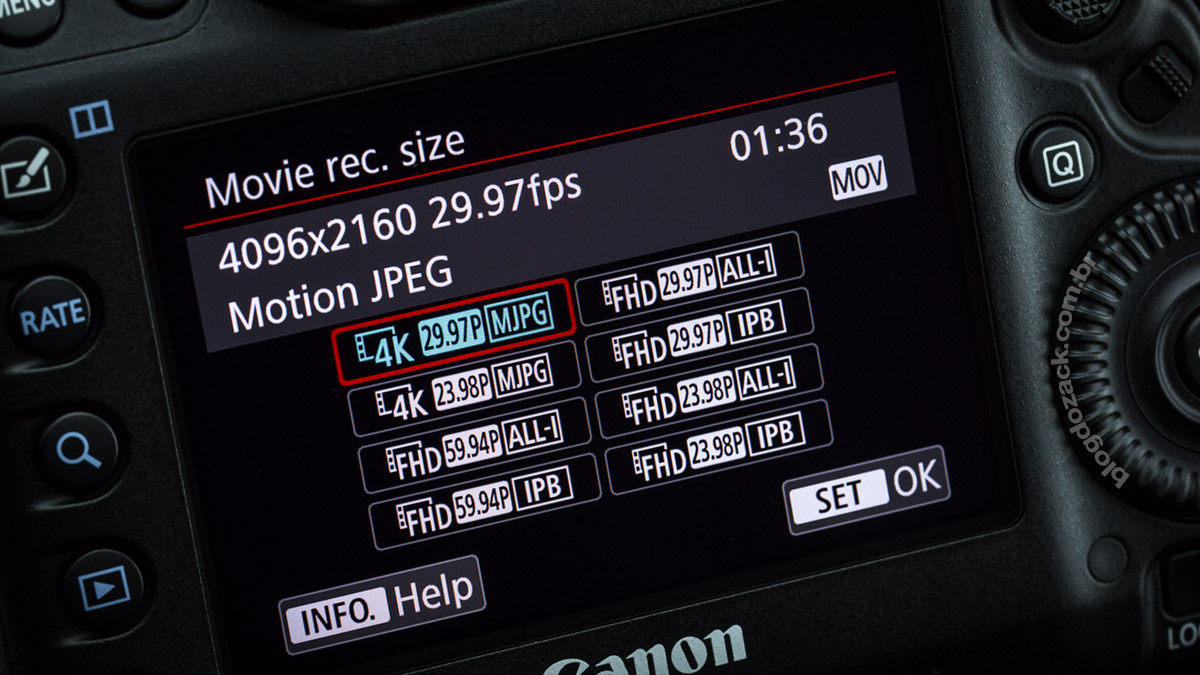
However each highlight came with its own limitations, and the 5D Mark IV might not the 4K-full frame wonder one might have expected. Starting with the DCI-4K capture, it’s not made on the full sensor area. In the name of image quality, Canon opted to use a center crop at 4096×2160, that’s about 1.64x the 30.1MP (6720×4480) full frame resolution; giving us less than an APS-C sized area to work with. It completely changes the look and framing from true “full frame video”, as we must compensate for the camera’s position and focal length choices in order to work-around the smaller area. For example headshots done with an EF 85mm f/1.2 L II USM and its shallow depth of field, look nowhere as shallow with an EF 50mm f/1.2L USM; as the aperture is relatively smaller. Finding wide angle lenses can also be a challenge, besides not being impossible: you can use DX/DC lenses from third parties (not EF-S), like the Tokina AT-X Pro DX 11-20mm f/2.8, to give the Mark IV a sense of wide angle. Also as the readout area is small, the sensor is prone to rolling shutter, distorting vertical lines on high paced scenes. The image crop is almost unforgivable given a market filled with Sony’s A7 mirrorless, but it’s not fatal if you use some creativity.
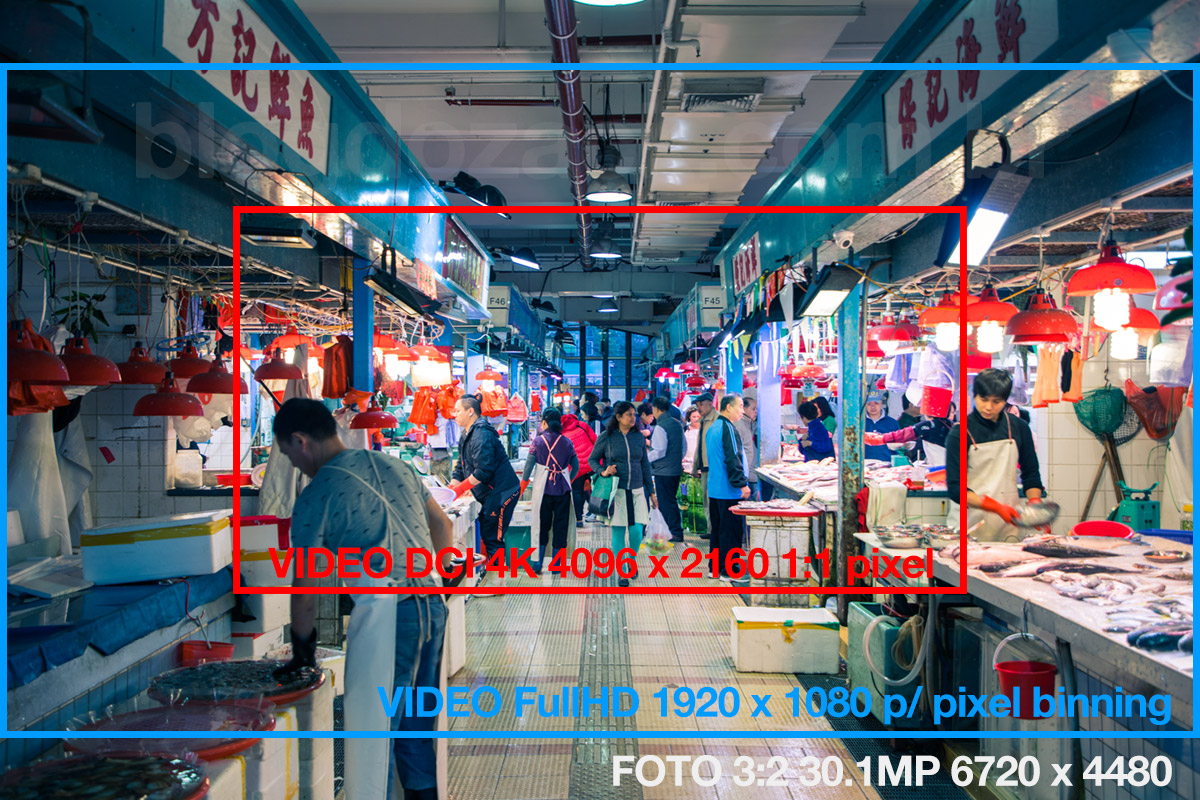
Other “curiosities” over the 4K capture is the DCI (Digital Cinema Initiative) standard, and the Motion JPEG codec; both different from what’s used on most consumer cameras. The first is actually an advantage: thought for cinema production, the DCI-4K uses a longer horizontal resolution (4096×2160) than the 4K-UHD (3840×2160) video ratio at 16:9. So the Mark IV framing is slightly different if you’re planning on using it among various cameras, and a bit of a headache in post. The Motion JPEG recording is another treat from Canon but, again, thought for cinema (and photo) production. As the camera literally packs a sequence of JPEG images in a single video file, it’s extremely light on the DIGIC6+ CPU (that never overheats), and allows for Canon’s “video frame grab” function; that exports 8MP JPEGs from video sequences, something few people really use. But it’s very heavy on files sizes, asking for 32GB per 8 minutes of capture; impossible to record longer sessions. However the advantage is on the image quality: there’s practically no loss in compression, at about 500Mbps, and the files are beautiful straight from the camera.

STILL talking about its limitations, the HDMI works only at 1080P60 (no 4K), not that different from the Mark III’s 1080P30; and the camera lacks any video assistants during capture; again, unforgivable for a third generation EOS Movie 5D (the classic 5D had no video). The 1080P60 HDMI gives no reason to upgrade the camera for video production; those using the Mark III probably switched to a Sony Alpha 7 for the same price. The lack of assistance for focusing (peaking), exposure (zebras) or even built-in masks to conform with various standards (like 4K-DCI to 4K-UHD) only make the limited HDMI worse; Canon doesn’t help you in camera and you can’t really help yourself externally. And if it wasn’t bad enough, the Mark IV also leaves any form of Log capture out of the picture (no pun-intended); lagging behind Sony’s A6300 advanced S-Log; or Fuji’s X-T2 F-Log; both half the price the Mark IV. So the Canon borderlines the absurd: it’s pricier but less flexible than any camera, forcing to consider an overprice C500II for 4K video.
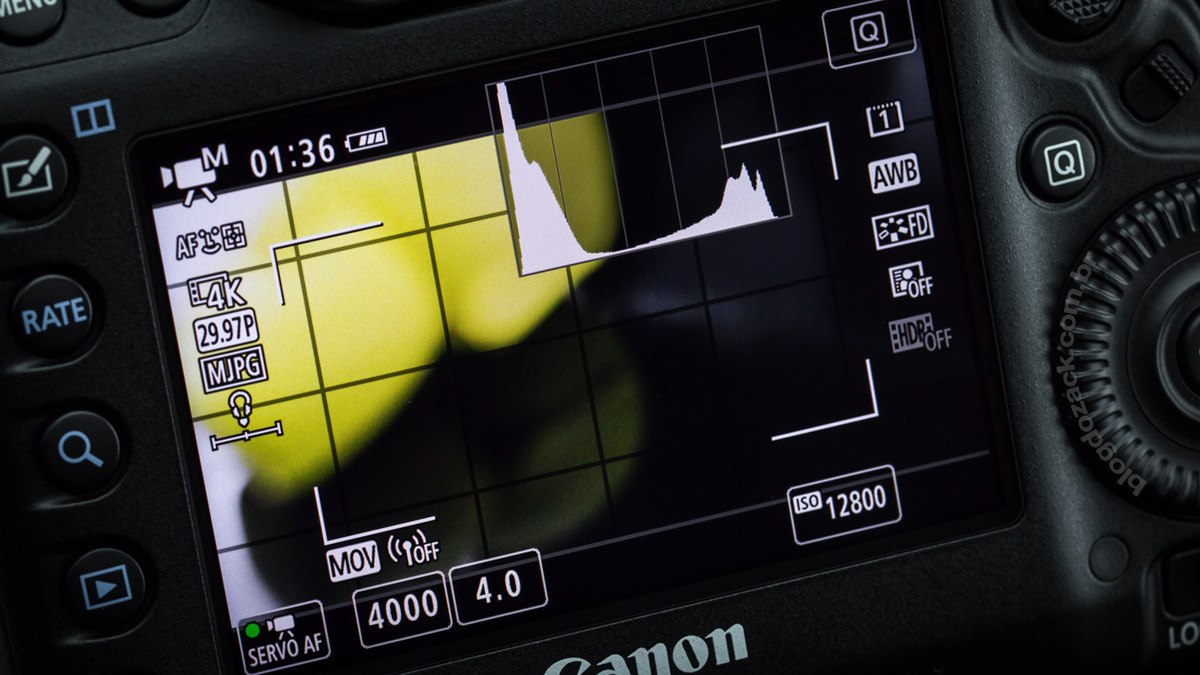
If any of these limitations take away from Canon’s brilliant image quality straight from the camera, now at DCI-4K? Abso-fucking-lutely NOT! I’ve never been more pleased with the video coming from a photographic camera as I am with the EOS 5D Mark IV. There’s practically no comparison: files are fiiiled with details, color nuances and more details (did I say details?), as no other EOS DSLR, all together with Canon’s great tones that other brands can only dream of. At higher ISOs, the videos show a fine noise print, as beautiful as those generated by Blackmagic’s Cinema Camera, lightyears ahead any mirrorless. Do you know that electronic look from Sony’s A6300, from a bizarre S-Log that turn anyone into an alien? Not on the 5D Mark IV. The lack of fineness from Fuji’s X-T2 dynamic range, crushing blacks or highlights on bizarre “Film Simulations”? Not on the 5D IV. Maybe the only DSLR comparable is the Nikon D500, but it does 4K on an even smaller crop (1.5x inside the APC-S chip), with a mandatory noise reduction that’s way too aggressive above ISO800. So the DCI-4K from the 5D Mark IV looks awesome, rich in details and colors.
Just like shooting through the LCD, all Dual Pixel’s features migrated to the EOS Movie, a Live View “feature” that, once again, is a paradigm shift compared to the rest of the market. Forget Sony’s A7RII S-Log full frame 4K; or Fuji’s X-Trans X-T2 weird colors. Canon’s big idea is to enhance the 5D Mark IV video ergonomics, automating the auto-focus to essentially generate different videos, no matter the specs limitations. It’s brilliant: smooth focus transitions or fast subject-to-subject tracking, with practically no effort from the operator, all with professional finishing. It works like that: activate the Movie SERVO AF in camera, choose the focus point method (auto with face tracking, or a touch-sensitive flexible zone), set a transition speed (with 8 options) and sensitivity (locked-on or responsive); and press record. With EF STM/USM lenses, the focusing transition is smooth and linear from start to end, every time, effortlessly.
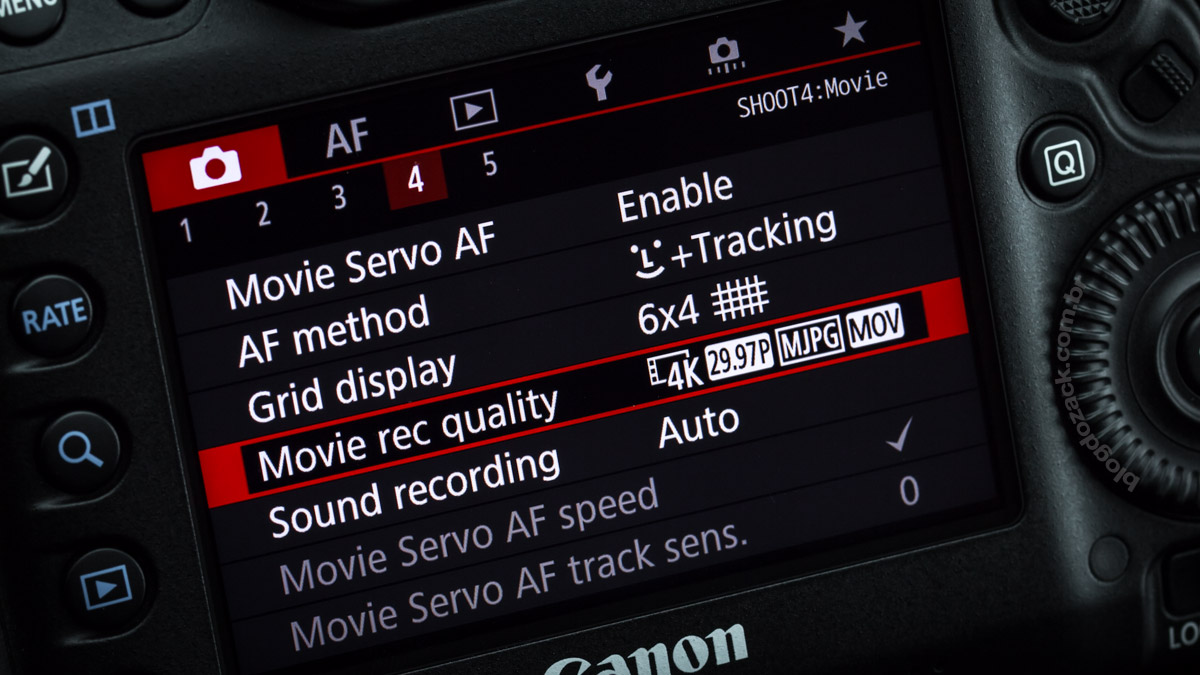
That’s Canon EOS 5D Mark IV greatest triumph: to put the Dual Pixel tech on it’s most popular full frame camera, and bet on its auto-focusing heritage to compete on the tech-filled digital photography market. The purchasing decision essentially comes from this, as Canon refuses to meet most standard wishes. For full frame Full HD video, the Mark IV is a slight update to the Mark III, only doubling the frame rate (1080P60 vs. 1080P30), still with no focusing assistance, exposure or log profile; things that any four-year-old smartphone does better, from you shirts pocket. For 4K capture, the Mark IV is less flexible than any mirrorless camera costing 1/3 of the price (Sony A6300 APS-C for US$989), and reading a smaller sensor area that eliminates any advantage over shallower depths of field. But for ergonomics and practicality, with perfect focus transitions and perfect straight-of-the-camera images, its the bread-and-butter we expect from EOS’s cameras: turn it on, press REC, and leave with a perfect job, straight from the camera.
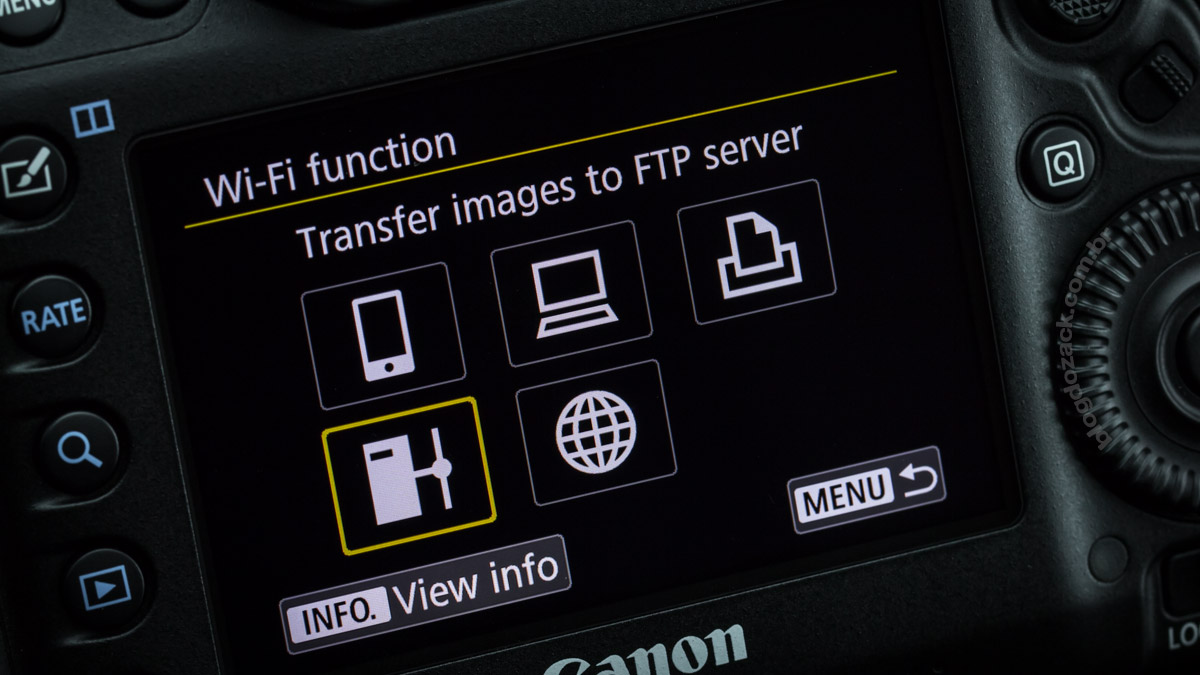
The Canon EOS 5D Mark IV is the first “connected” 5D, and got every wireless connection conceivable. It’s the complete package: a 802.11 b/g/n (no a/c) Wi-Fi module for faraway control; a NFC chip for instant pairing with compatible devices; and a GPS receiver, to include geotag data on photo files. The software itself is the most advanced ever in Canon’s history, and the best in class: besides the easy pairing with any smartphone (Android or iOS), for file transfers or a complete Live View experience; and the direct, wireless connection to a PC and the Digital Photo Professional suite, also with full-camera-control or file transfer directly to the hard-drive; a new in-camera FTP (fire transfer protocol) option allows for instant backing-up of files in the cloud, like never seen before. Again, for the forth time in this review: it’s way more advanced than any other brand, with Canon’s typical ergonomics, for a function that more people will be using.
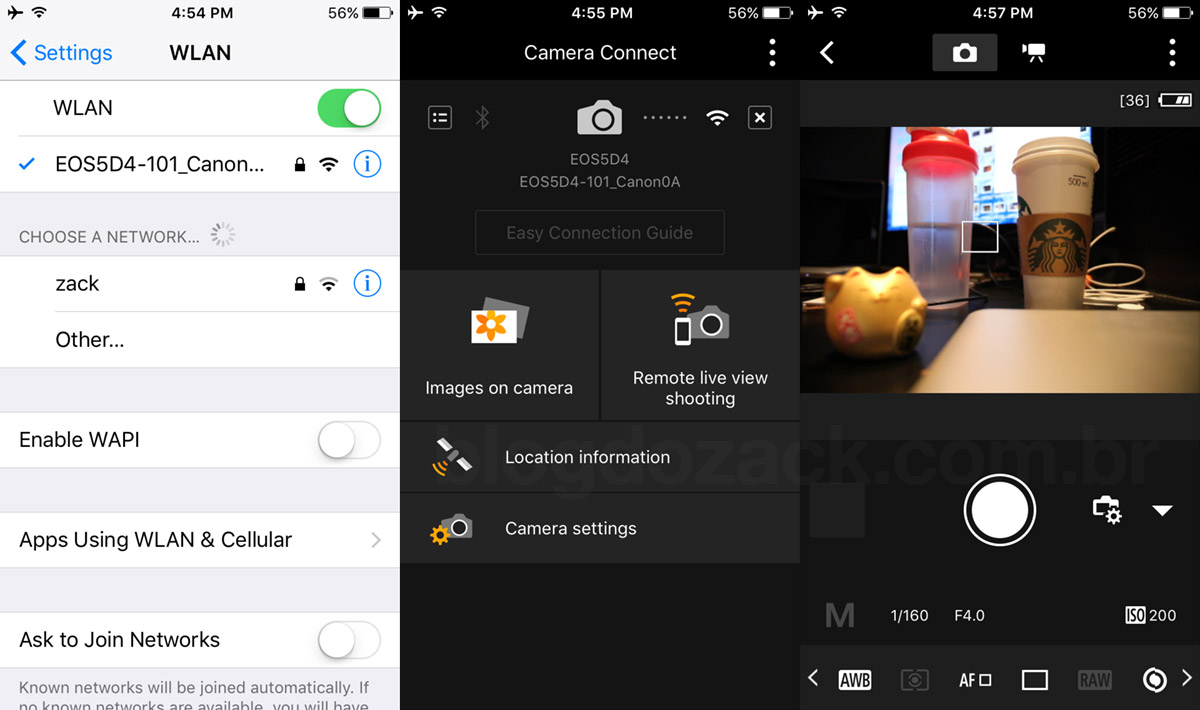
Connecting with a smartphone could not be easier. 1) On the phone, download Canon’s Camera Connect (CCC) app, necessary to interface with the camera. 2) On the camera, activate the wireless function and select two options: “easy”, which the camera creates its own network for ad-hoc connection; or “select network”, to use your own network. 3) Back on the phone, connect to the selected network and the communication is steady, free from dropouts; and that’s it. The CCC interface is clean, with options for downloading images or wireless camera control. This control is not limited to shooting only (Nikon) and some exposure settings (Fuji); it delivers ALL drive, AF-ON, quality, compression and white balance adjustments wirelessly. And a curious case-use is the connection is so reliable, one could use a smartphone just like a swivel screen; funny but doable.

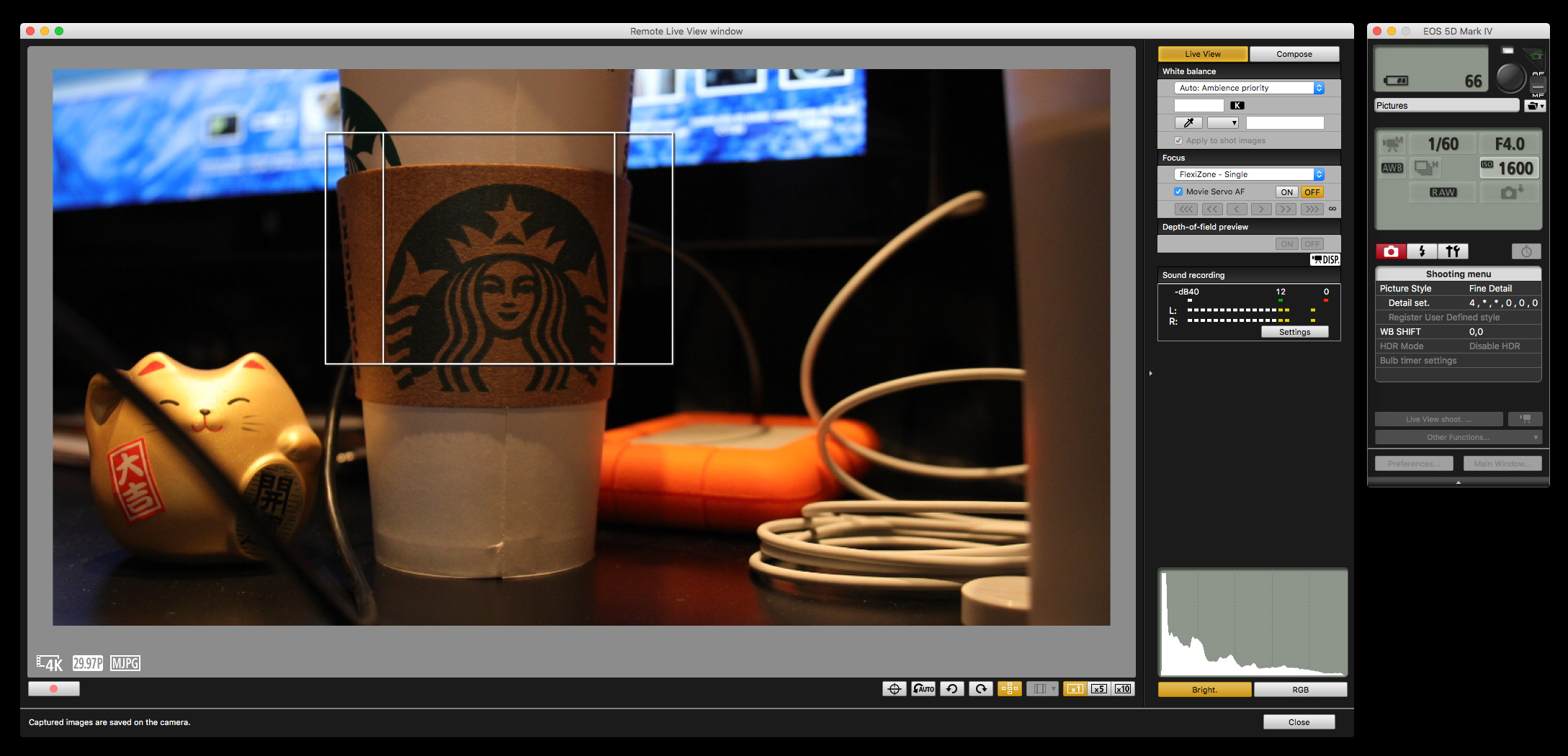
To connect to the PC’s Digital Photo Professional, the configuration is as simple, but made on a desktop. Instead of downloading an app, I only found Canon’s software supplied on a CD; a trip to the past for most computers. The camera connections are the same: easy (ad-hoc) or using the user’s own router, useful when you don’t want to disconnect from the internet. When setting up, both parts pair themselves once they’re logged on the same network, via EOS Utility. The Utility offers the same controls as the CCC, but takes it even further: it’s possible to download files (even raw) in real time, straight to the computer’s hard drive, for dynamic studio sessions. Unfortunately I didn’t find options to record video straight to the computer, that are still saved on camera. But it’s all easy to use remotely, without the need of an USB cable tethered like previous 5D’s.

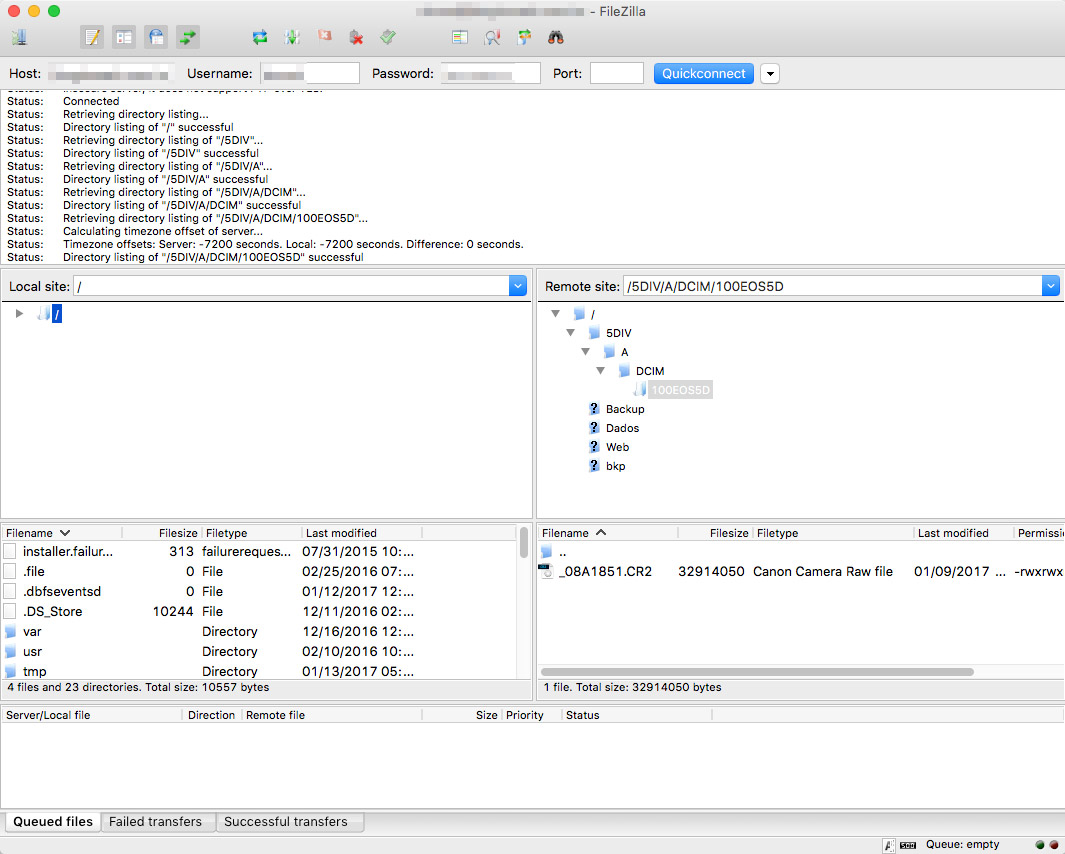
The file folder structure created by the EOS 5D Mark IV itself in FTP mode.
And at last, the 5D Mark IV Wi-Fi is the first EOS ever to establish a direct connection with a FTP server, for real time back-up of files to the cloud. Whether you own a private server or pay for a hosting service, it’s works in camera as easy as setting-up any website: choose a wireless network; quickly type, via the touch-screen, the “ftp.yourdomain” address; input login and password; and chose a folder structure (it doesn’t have to be in the root system). And that’s it. Canon gives you options for instant photo transfers, as soon as you click them; or to set up the rear SET button to send only the previous photo. Various file quality compression schemes can be selected, between hi-res JPEGs or even small/large raw. In large raw, each 30MB file takes about 60 seconds to upload, depending on your network’s bandwidth. But the camera does it all in the background, without hogging the CPU or locking-up any menu; noticeable by sudden flashes on the memory card LED. It’s much more reliable than depending on a social service to upload your photos (that can also be sent from the camera), and it works with any server; directly from your EOS camera!
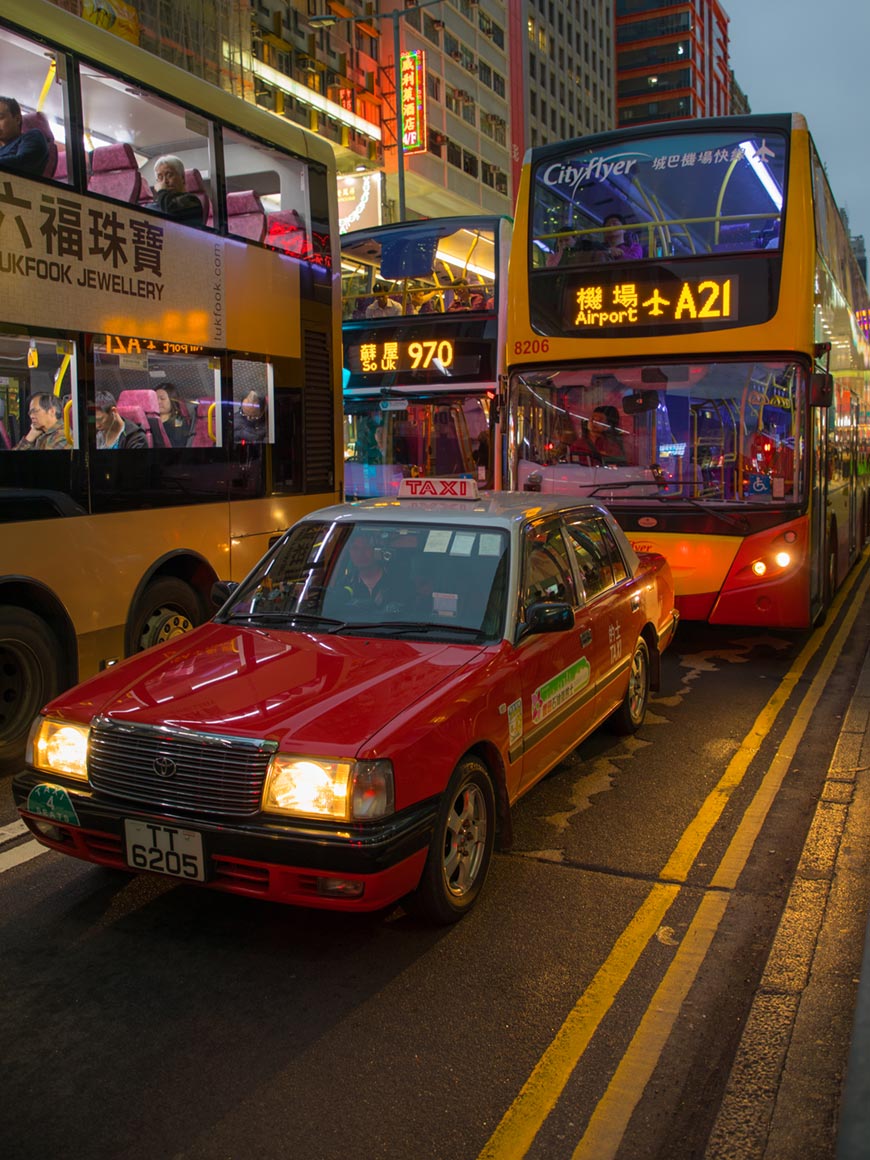
“Transport” with the EF 24-105mm f/4 L IS II USM at f/4 1/15 ISO400 @ 30mm; arquivos raw disponíveis no Patreon.
With a new 135 “full frame” CMOS sensor sporting 30.1MP 6720×4480 of resolution, the EOS 5D Mark IV also blends its imager with Canon’s technologies from APS-C and higher end cameras. The headline is the on-chip A/D design borrowed from the 1D-X Mark II, that instantly enhances the camera’s dynamic range at about +1.5EV at base-ISO; without distorting the colors. A sensor that tries to balance a higher pixel count with the signature 5D low light performance it finally surpasses the 30MP in spite of the Dual Pixel technology (it’s technically 60 million cells). It’s even more details for larger prints (57x38cm at 300ppi), and a natural advancement over the 22.3MP Mark III; that didn’t really improved the Mark II’s 21.1MP. The noise is discreet at higher ISOs, practically invisible between 100-3200 (!); smooth at 3200-6400; and loosing detail data only at 12.800 and above; all without giving up Canon’s colors up to ISO32.000, at 30MP under low light.
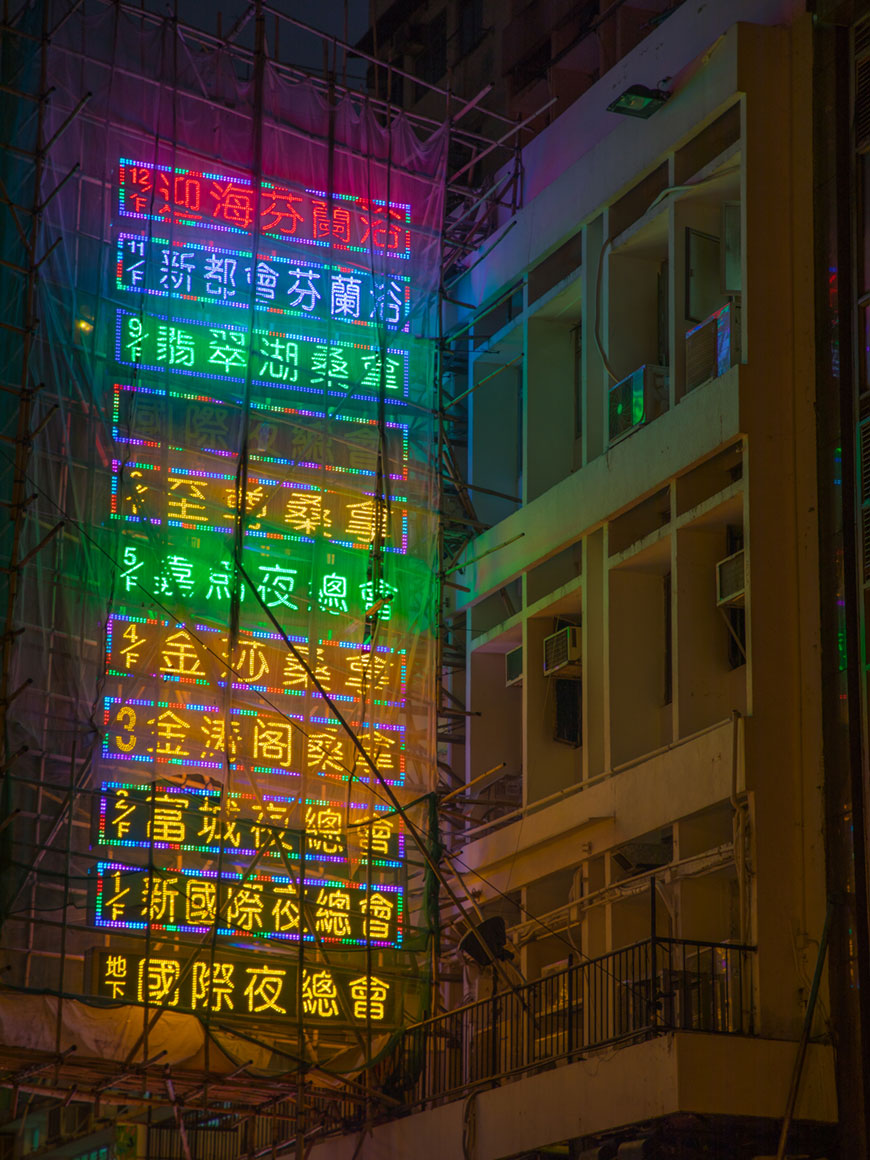
“Néon” with the EF 24-105mm f/4 L IS II USM at f/4 1/50 ISO4125 @ 97mm.
The higher resolution won’t make a world of difference over the previous Mark II and Mark III generations, but it’s certainly welcomed by those printing pictures. The files are even more detailed on urban landscapes with faraway signs, fine lines around buildings; each tree branch perfectly rendered on natural sceneries; all well defined on 30.1MP. The diffraction limit is at f/8.6, perfect to match optimized lens apertures in order to keep the camera’s highest resolution possible; a visible shortcoming on higher density cameras (+24MP APS-Cs or the 50.6MP 5DS), that suffer from diffraction as soon as f/5.6. It’s interesting to see how the Mark IV details are intact up to reasonably high ISOs (+3200), while the previous models fought for the same light. It wouldn’t make sense to push the resolution even higher and loose details out of the base-ISO, as it happens with the 5DS/R. The Mark IV is the perfect balance between resolution and low light performance for now, at least from a Dual Pixel (60 million photo-cells) sensor.
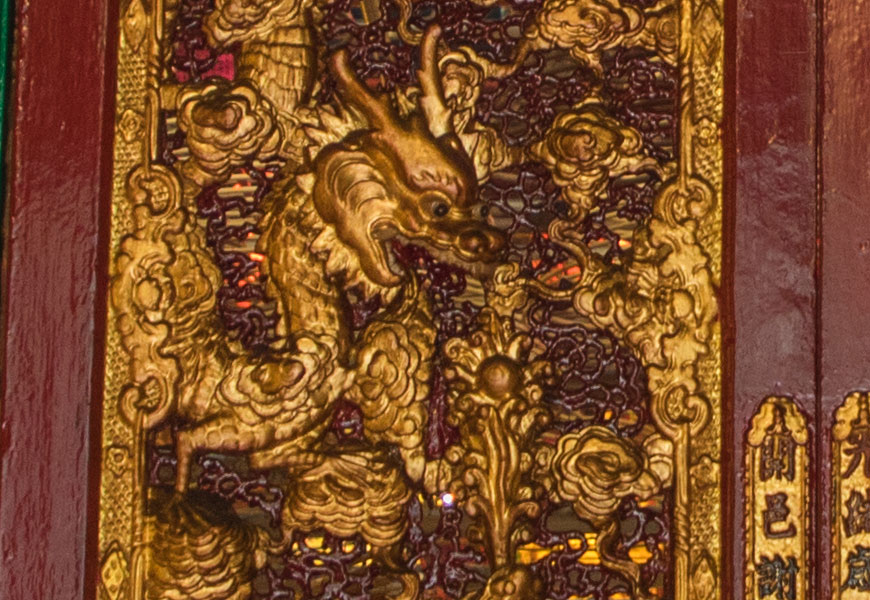
100% crop, enhanced details for large printing, in spite of the slight increase in resolution.
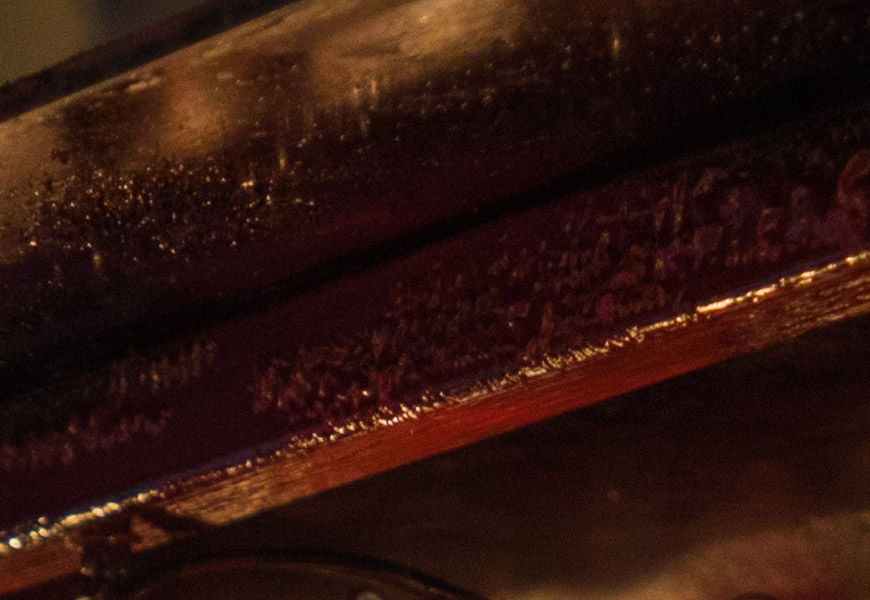
100% crop, the 5D Mark IV details are perfect straight from the camera.

100% crop, fine details are visible even at higher ISOs, like the 800.
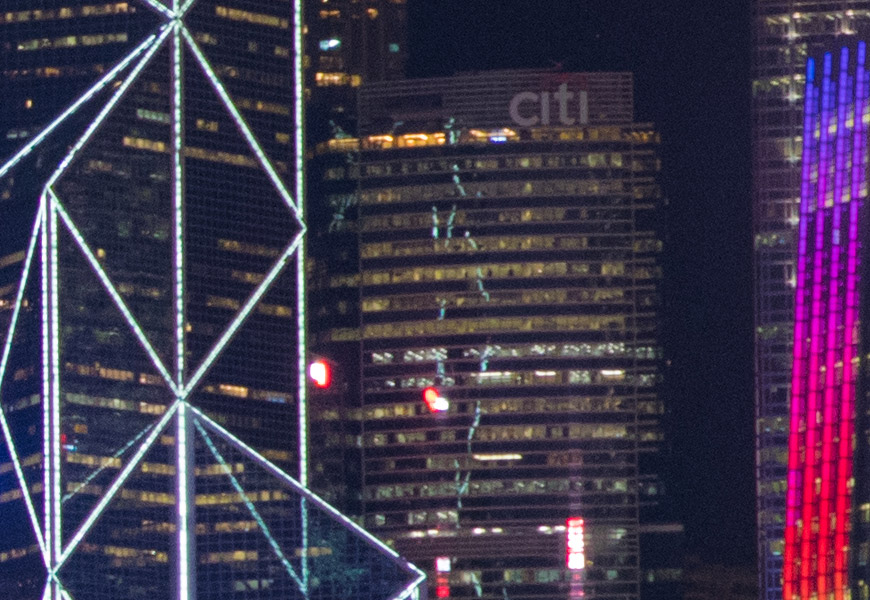
100% crop, nocturnal landscapes show high resolution under low light, the 5D lineup trademark.
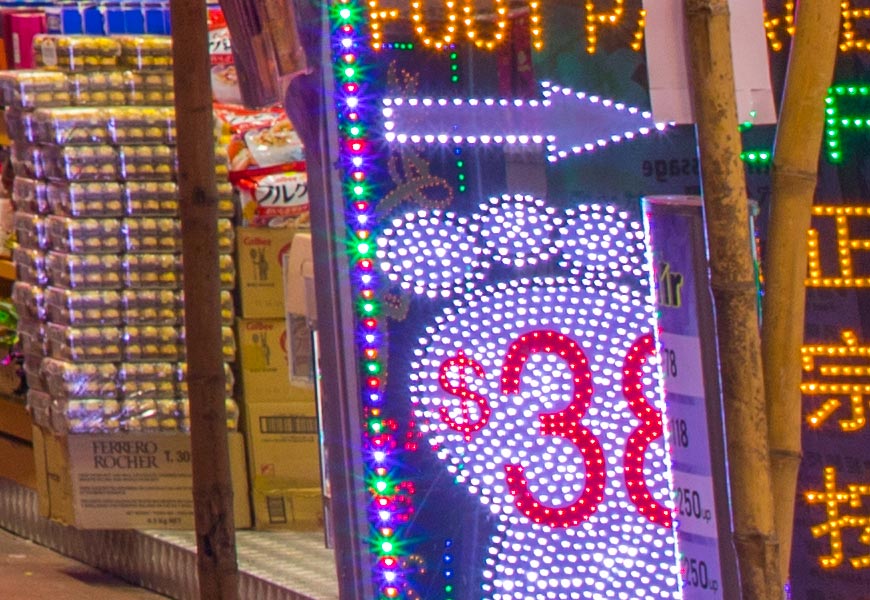
100% crop, high performance lenses, like the new 24-105mm II, take advantage of the extra resolution.
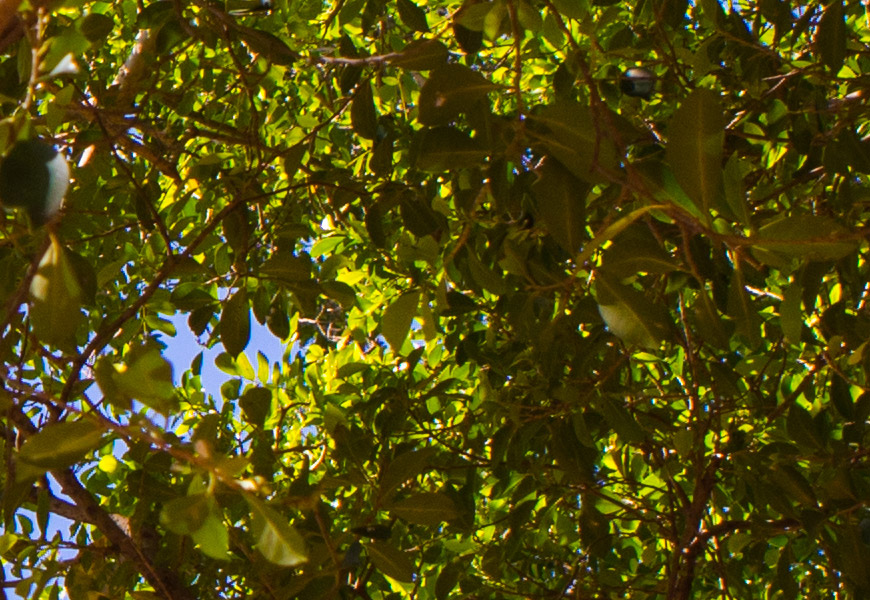
100% crop, practically every leaf is rendered on natural landscapes.
“Dojo” with the EF 24-105mm f/4 L II at f/8 1/50 ISO100 @ 31mm -0.75EV H-18 S+60 B+65.The expanded dynamic range is the 5D Mark IV biggest image quality highlight, employing a new sensor design borrowed from the top of the line. On the Mark II, that camera used the 1D-Mark IV’s micro-lenses. On the Mark III’s, the micro-lenses became gapless to improve the sensor light gathering capabilities. On the Mark IV, the imager brings an on-chip A/D design, that avoids electrons escaping from the board itself, generating heat; first seen on the EOS 1D-X Mark II. In practice Canon instantly enhanced the dynamic range at +1.5EV, visible mostly on pushed shadows from raw files, without any signs of color degradation; vastly superior to the Mark III and the EOS 6D. Despite not comparing to other brand’s dynamic range that – in plain english – don’t give a fuck about color tonality, Canon maintains itself faithful to its own CMOS colors, no matter the higher dynamic range. (Adobe Camera Raw data, H = highlights, S = Shadows, B = Blacks)
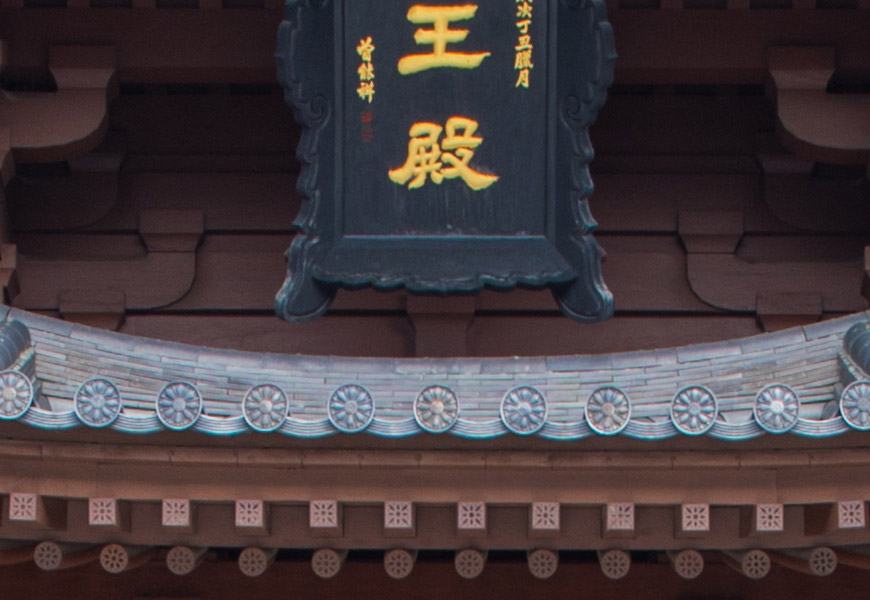
100% crop, practically no extra noise on an ISO100 file, perfect for Canon’s standard.
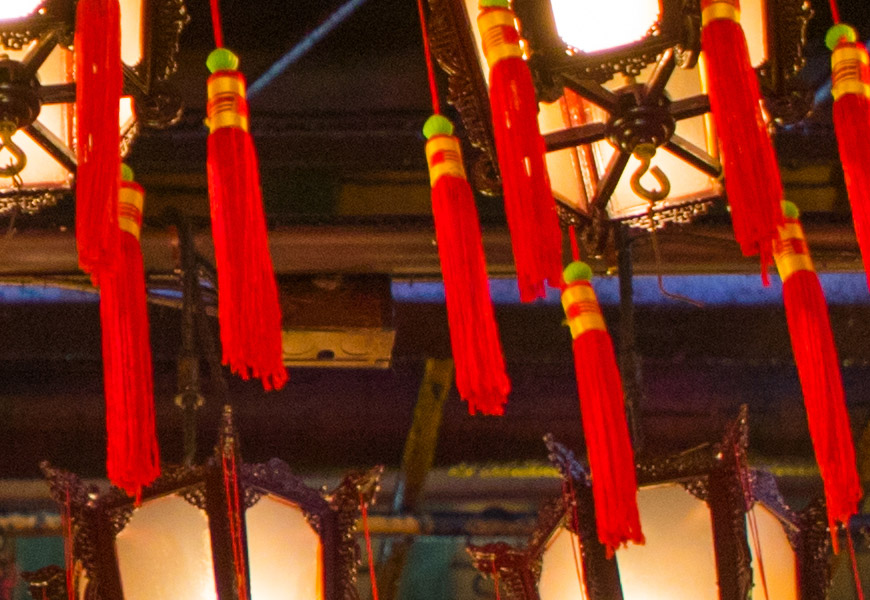
100% crop, intact details are saturated reds, typical of Canon; try that on your D810. ;-)
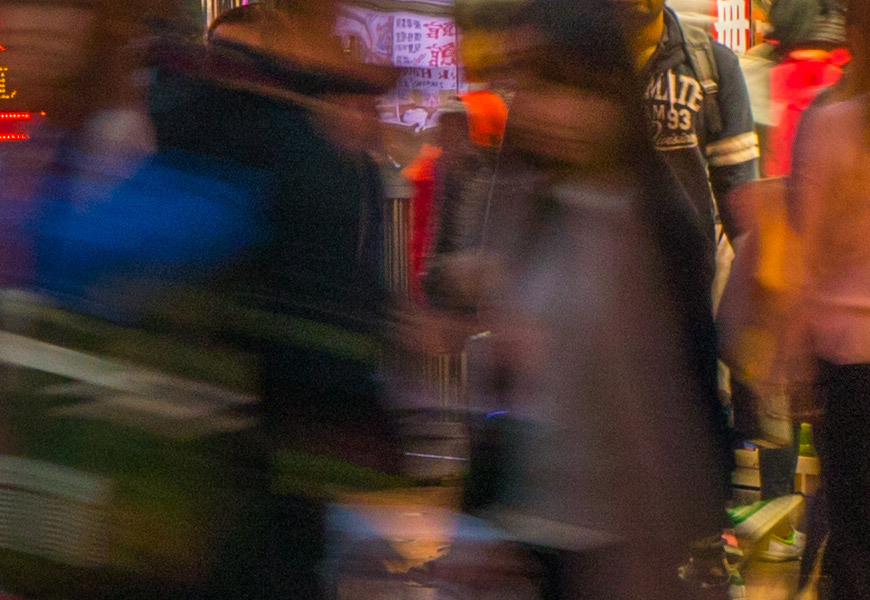
100% crop, extreme file compensation, practically a single-click HDR, with no noise on the shadows.
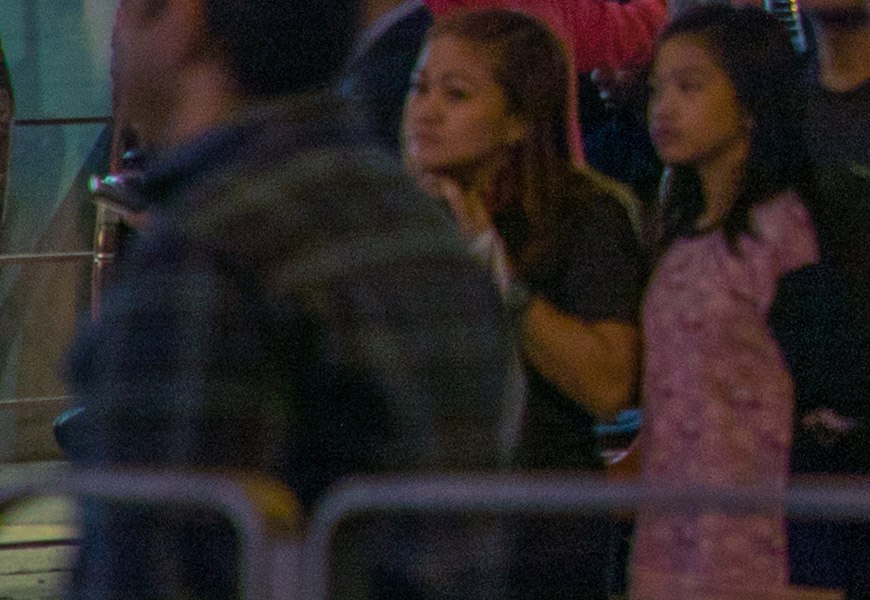
100% crop, considerably more noise in spite of the ISO160, like Fuji’s cameras.

100% crop, signs of banding from the on-chip ADC sensor, but the colors are intact.
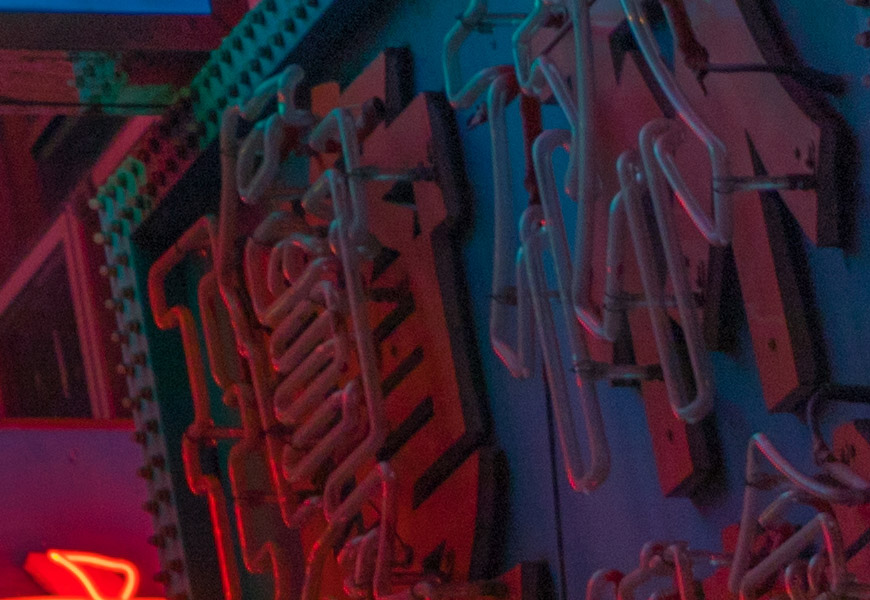
100% crop, no signs of shadow aberrations, in spite of the overly pushed blacks and shadows.
The high ISO noise continues discreet and with even more details, the foundation of the EOS 5D lineup. At modest ISOs like 1000 and 2000, a fine mesh of brighter and darker pixels cover most of Mark IV files, invisible on high quality prints at native resolution (57x38cm at 300ppi). Even higher ISOs like 3200 to 5000 are perfect for low light shooting (imagine 1/200 at f/8 indoors), sporting an denser mesh when pixel peeping, giving the digital capture an analog look, complimentary to the paper’s texture in prints. Only at absurd ISO values like 8000 and above, the details are not the 5D Mark IV’s priority, in spite of Canon’s intact colors; beautifully rendered even in low light, allowing for modest prints, under A3. Although there’s not much improvement over the previous Mark III or even the 6D, the Mark IV does it at 50% more pixels AND uses a Dual Pixel sensor. We can’t have it all and Canon bet on the Dual Pixel (with twice the photo cells) instead of enhancing the low light performance, at higher ISOs (good enough on the Mark III).

100% crop, no signs of noise at the base-ISO, a Canon “invention” since the use of CMOS imagers on its DSLRs.
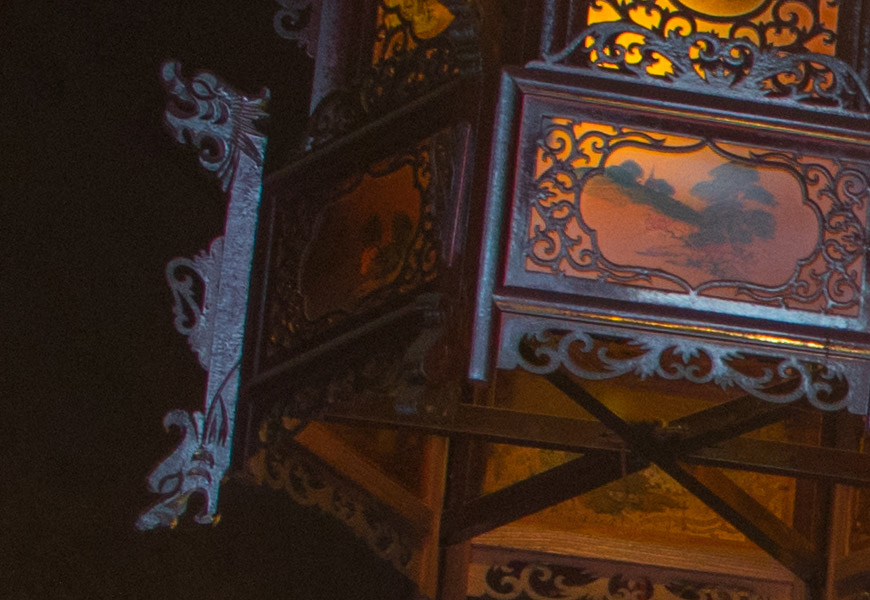
100% crop, intact details and no signs of noise at ISO640, the reason to have a full frame camera.
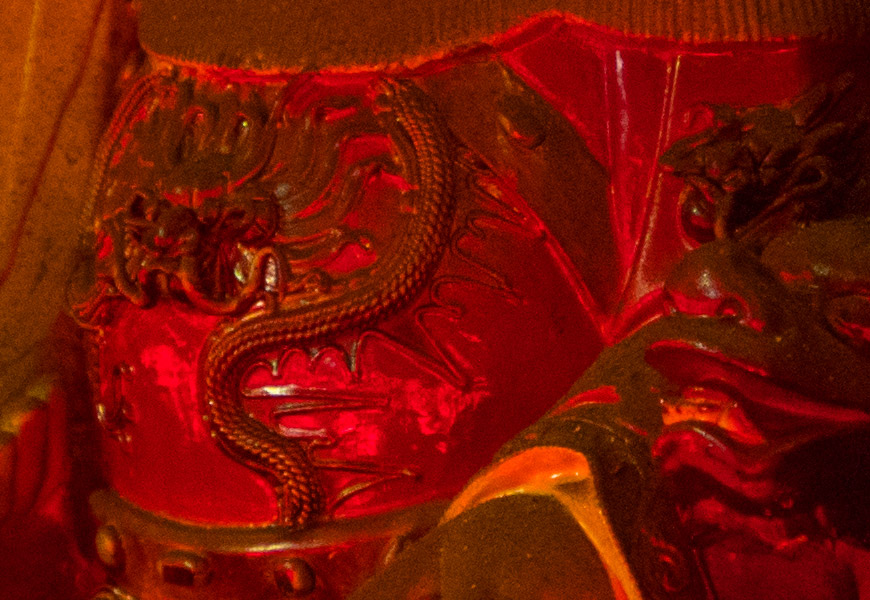
100% crop, still a low-noise-footprint, no matter the relatively high ISO2000.

100% crop, very high ISO starts to fight against the details.

100% crop, shadows noise but intact highlights.

100% crop, colors, ah, Canon’s colors, in spite of the extreme ISO!
Finally Canon’s colors seal the EOS 5D Mark IV deal, intact in tone and saturation despite the new Dual Pixel. It’s always the main reason why most photographers prefer and stick to Canon: colors are far from reality but look great on paper and screens. Landscapes look alive with deep-blue skies. Sunsets are warmer than what the eyes see, enhancing yellows and reds. The green tint on tree are mixed with brown tones that other brands refuses to “see”. Skin tones are perfectly colored, from the whitest make-up-heavy asian pink; to the darkest African yellow-ocre-brown. Chatting with some of vlog do zack’s followers, it’s always funny to see how some switch to other brands, looking for newer tech (BSI sensors, more dynamic range), but comes back to Canon! Nikon “pushes” portraits to greenish tones; Sony insists on subdue skin tones; and Fuji plays with Instagram filters, for files publishable only by hipsters magazines. But the 5D Mark IV keeps the tones we’re used to for more than a decade on every digital camera, from Canon’s EOS lineup.
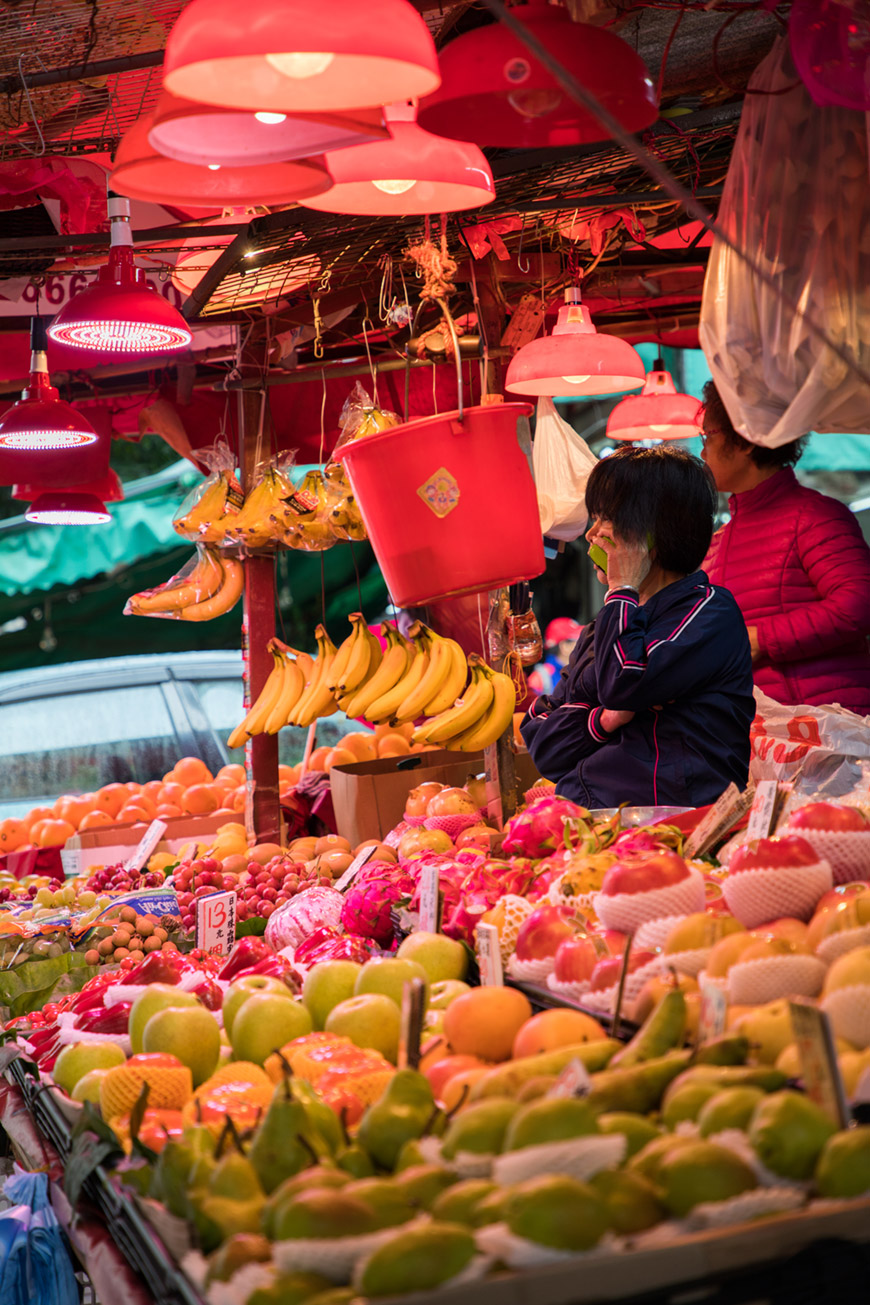
“Feira” with the EF 24-105mm f/4 L IS II USM at f/4 1/100 ISO200 @ 105mm.
Canon doesn’t have a winner on the 5D Mark IV, it has a paradigm shifter for full frame cameras: a Dual Pixel sensor, that’s not easy to do; and the low light and color performance we’re used to on all EOS’s. A natural step for Canon, that tests new techs on APS-C camera, for latter bringing it to the full frame market; reversing the product development logic (from bottom to top), to keep every EOS camera in the same league. Who could image the 70D (2013) sensor would be the foundation for future EOS cameras, and the Dual Pixel tech would make itself to professionals? It makes sense: the ergonomics, quick controls and auto-focus from a viewfinder-based experience has little to be improved, so it’s worth experimenting with new ways of shooting. That’s the 5D lineup moto. The Mark II’s Live View revolutionized the video market, with photographers joining the party with a 21.1MP sensor. The Mark III’s pixel binned video enhanced the EOS Movie resolution, and photographer’s enjoyed a new, ultra-flexible 61-point phase detection module. And on the Mark IV, Canon is giving all its TLC to both, combining the fast, phase-detection principle in the full frame image sensor, with over 60 million photo-cells for fast AF during Live View photos and videos.
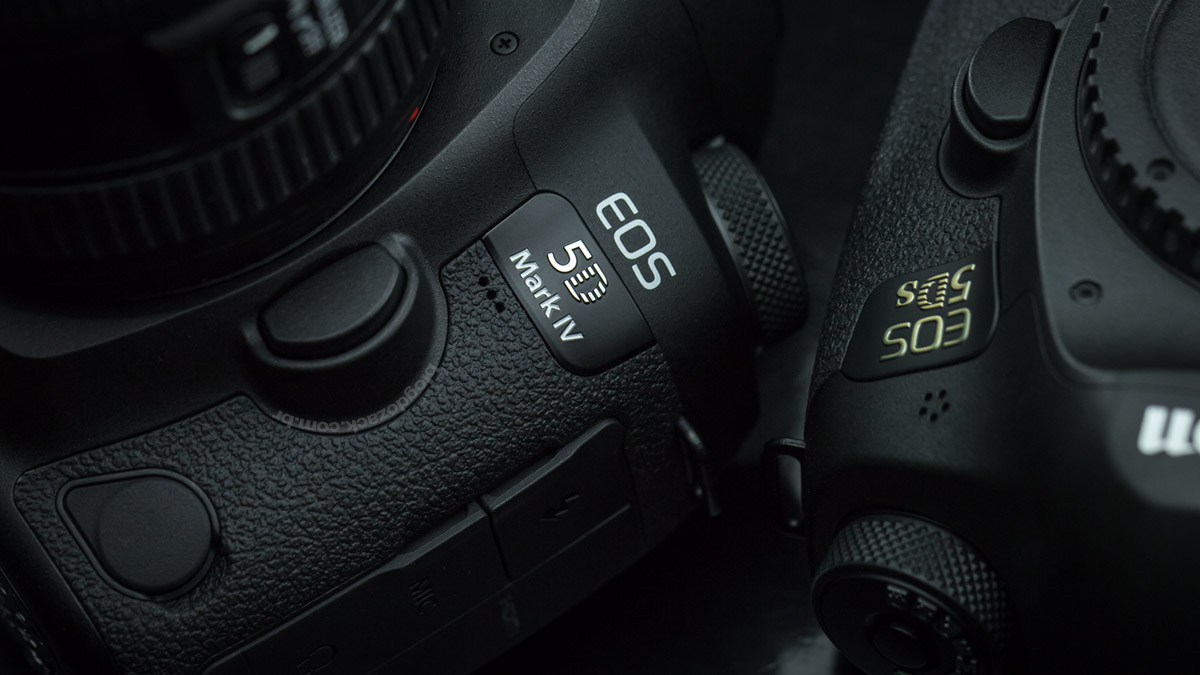
Did it work? Absolutely. The 5D Mark IV does what no other camera ever did, and all with a full frame sensor. The ergonomics are brilliant, vastly superior to any other brand. Nikon’s D800E grip was too thin. The D750 screen didn’t behave. Sony’s A7II handling is a joke. And, honestly, even Canon’s own 6D looks like a toy compared to the all-magnesium 5D body. The Mark IV got new curves and controls to make photographers addicted to its layout, for everyday usage; those working with a Mark III must buy the IV immediately. The overall performance is a giant step forward the older DIGIC5, plus an innovative, faster, smoother, quieter mirror mechanism; paired with an intelligent viewfinder and metering, that feed the AF-module with incredible data, to track any subject. And what used to be a bonus, now it’s serious business: the Dual Pixel Live View gives us better auto-focus than even the viewfinder, signaling Canon’s future based on its most valuable asset – the trustworthy AF. Those shooting video, the cropped-4K might not be what we were looking for, but it’s far from useless. It’s ergonomics are wonderful with a touch screen and amazing focus racking capabilities. And the image quality… Well, it’s Canon’s great color science but now at 30MP with plenty of dynamic range. For the price, the Mark IV is a mandatory upgrade for 5D shooters, as nothing comes close on the market. Just buy one, and nice shooting!